Investment Analysis and Workforce Planning
VerifiedAdded on 2020/01/23
|19
|5449
|164
Report
AI Summary
This assignment presents a detailed analysis of an investment portfolio comprising various stocks and bonds. The analysis includes calculations of expected returns, capital gains, and total values at maturity. Additionally, the assignment delves into workforce planning by estimating the number of employees that can be hired based on the generated investment income. Tables provide clear visualizations of the financial data and calculations involved.
Contribute Materials
Your contribution can guide someone’s learning journey. Share your
documents today.
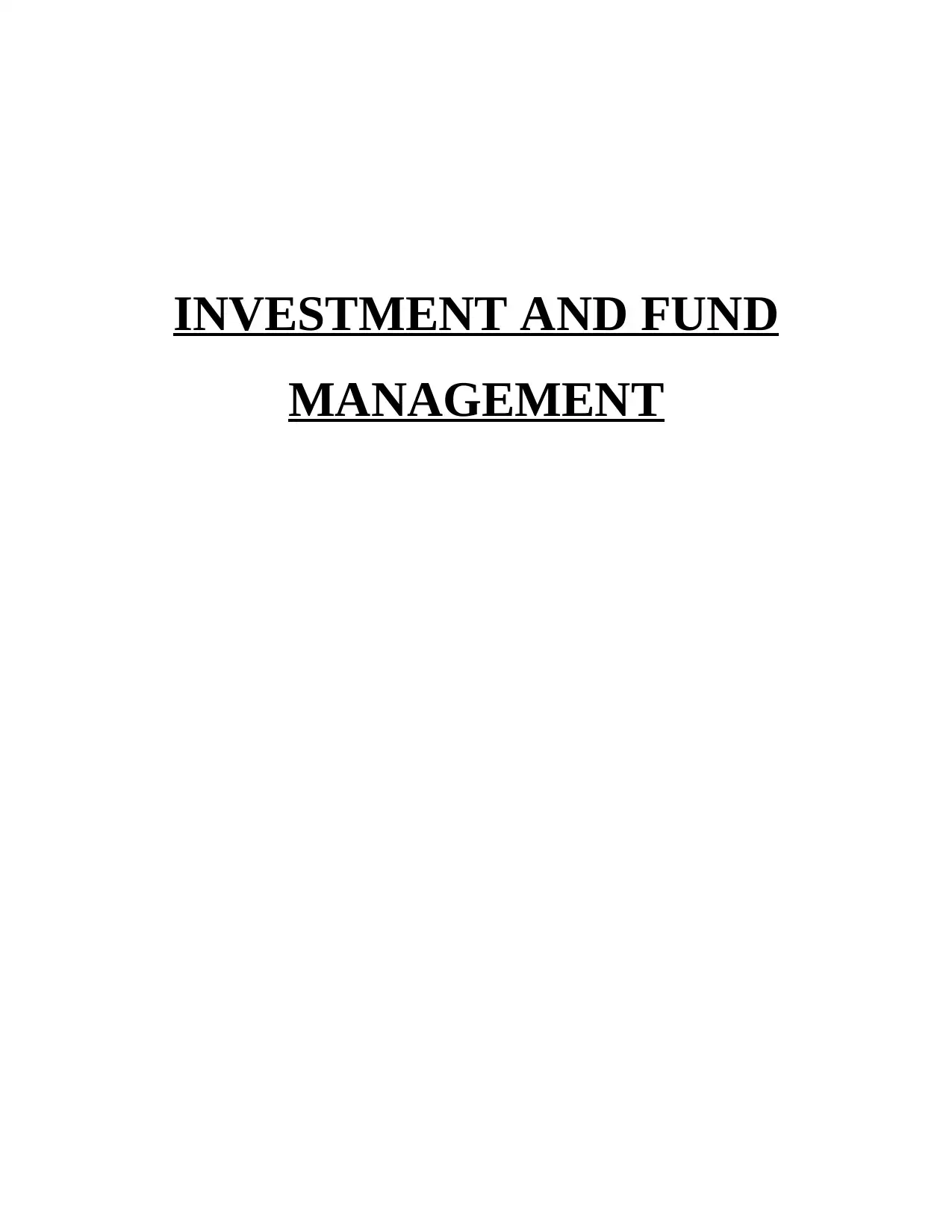
INVESTMENT AND FUND
MANAGEMENT
MANAGEMENT
Secure Best Marks with AI Grader
Need help grading? Try our AI Grader for instant feedback on your assignments.
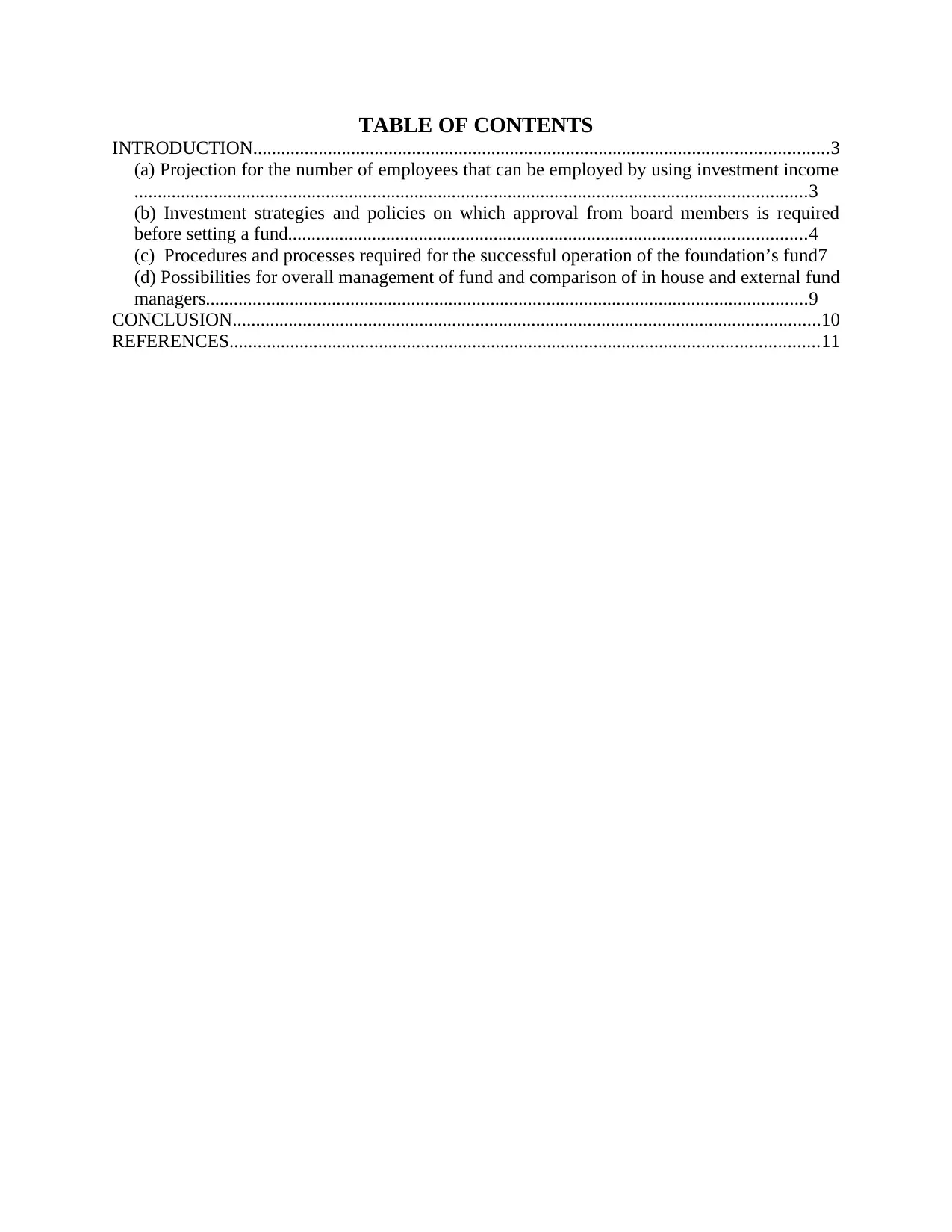
TABLE OF CONTENTS
INTRODUCTION...........................................................................................................................3
(a) Projection for the number of employees that can be employed by using investment income
................................................................................................................................................3
(b) Investment strategies and policies on which approval from board members is required
before setting a fund...............................................................................................................4
(c) Procedures and processes required for the successful operation of the foundation’s fund7
(d) Possibilities for overall management of fund and comparison of in house and external fund
managers.................................................................................................................................9
CONCLUSION..............................................................................................................................10
REFERENCES..............................................................................................................................11
INTRODUCTION...........................................................................................................................3
(a) Projection for the number of employees that can be employed by using investment income
................................................................................................................................................3
(b) Investment strategies and policies on which approval from board members is required
before setting a fund...............................................................................................................4
(c) Procedures and processes required for the successful operation of the foundation’s fund7
(d) Possibilities for overall management of fund and comparison of in house and external fund
managers.................................................................................................................................9
CONCLUSION..............................................................................................................................10
REFERENCES..............................................................................................................................11
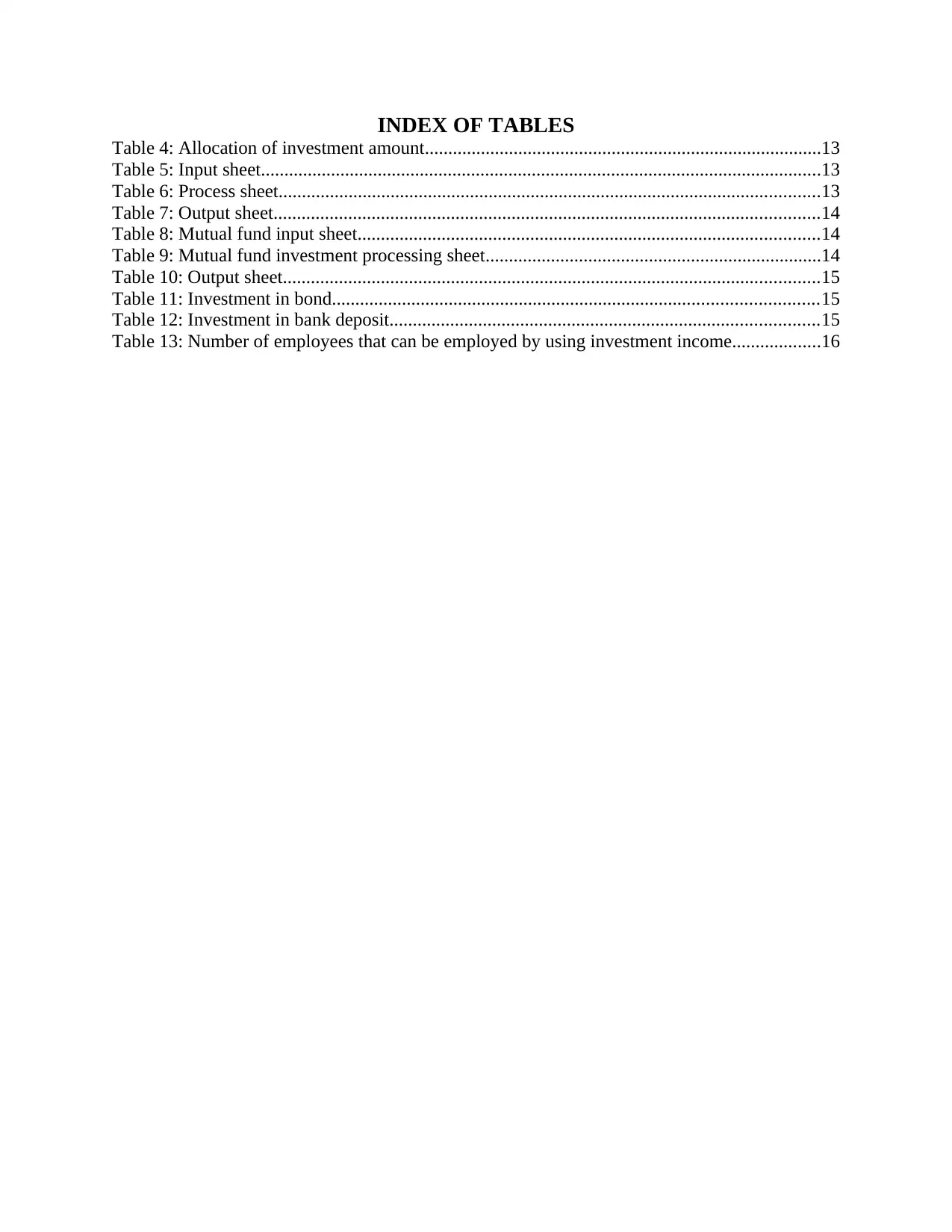
INDEX OF TABLES
Table 4: Allocation of investment amount.....................................................................................13
Table 5: Input sheet........................................................................................................................13
Table 6: Process sheet....................................................................................................................13
Table 7: Output sheet.....................................................................................................................14
Table 8: Mutual fund input sheet...................................................................................................14
Table 9: Mutual fund investment processing sheet........................................................................14
Table 10: Output sheet...................................................................................................................15
Table 11: Investment in bond........................................................................................................15
Table 12: Investment in bank deposit............................................................................................15
Table 13: Number of employees that can be employed by using investment income...................16
Table 4: Allocation of investment amount.....................................................................................13
Table 5: Input sheet........................................................................................................................13
Table 6: Process sheet....................................................................................................................13
Table 7: Output sheet.....................................................................................................................14
Table 8: Mutual fund input sheet...................................................................................................14
Table 9: Mutual fund investment processing sheet........................................................................14
Table 10: Output sheet...................................................................................................................15
Table 11: Investment in bond........................................................................................................15
Table 12: Investment in bank deposit............................................................................................15
Table 13: Number of employees that can be employed by using investment income...................16
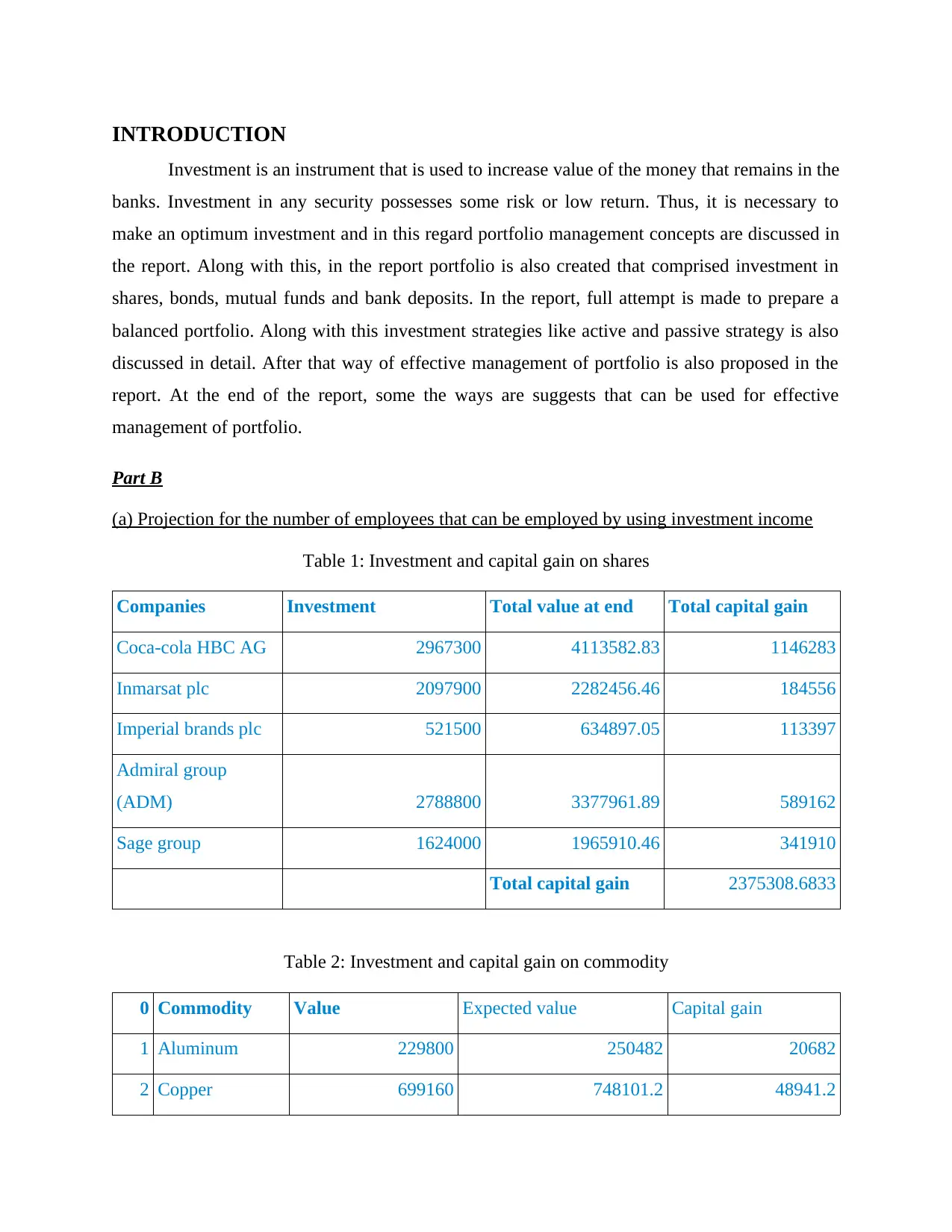
INTRODUCTION
Investment is an instrument that is used to increase value of the money that remains in the
banks. Investment in any security possesses some risk or low return. Thus, it is necessary to
make an optimum investment and in this regard portfolio management concepts are discussed in
the report. Along with this, in the report portfolio is also created that comprised investment in
shares, bonds, mutual funds and bank deposits. In the report, full attempt is made to prepare a
balanced portfolio. Along with this investment strategies like active and passive strategy is also
discussed in detail. After that way of effective management of portfolio is also proposed in the
report. At the end of the report, some the ways are suggests that can be used for effective
management of portfolio.
Part B
(a) Projection for the number of employees that can be employed by using investment income
Table 1: Investment and capital gain on shares
Companies Investment Total value at end Total capital gain
Coca-cola HBC AG 2967300 4113582.83 1146283
Inmarsat plc 2097900 2282456.46 184556
Imperial brands plc 521500 634897.05 113397
Admiral group
(ADM) 2788800 3377961.89 589162
Sage group 1624000 1965910.46 341910
Total capital gain 2375308.6833
Table 2: Investment and capital gain on commodity
0 Commodity Value Expected value Capital gain
1 Aluminum 229800 250482 20682
2 Copper 699160 748101.2 48941.2
Investment is an instrument that is used to increase value of the money that remains in the
banks. Investment in any security possesses some risk or low return. Thus, it is necessary to
make an optimum investment and in this regard portfolio management concepts are discussed in
the report. Along with this, in the report portfolio is also created that comprised investment in
shares, bonds, mutual funds and bank deposits. In the report, full attempt is made to prepare a
balanced portfolio. Along with this investment strategies like active and passive strategy is also
discussed in detail. After that way of effective management of portfolio is also proposed in the
report. At the end of the report, some the ways are suggests that can be used for effective
management of portfolio.
Part B
(a) Projection for the number of employees that can be employed by using investment income
Table 1: Investment and capital gain on shares
Companies Investment Total value at end Total capital gain
Coca-cola HBC AG 2967300 4113582.83 1146283
Inmarsat plc 2097900 2282456.46 184556
Imperial brands plc 521500 634897.05 113397
Admiral group
(ADM) 2788800 3377961.89 589162
Sage group 1624000 1965910.46 341910
Total capital gain 2375308.6833
Table 2: Investment and capital gain on commodity
0 Commodity Value Expected value Capital gain
1 Aluminum 229800 250482 20682
2 Copper 699160 748101.2 48941.2
Secure Best Marks with AI Grader
Need help grading? Try our AI Grader for instant feedback on your assignments.
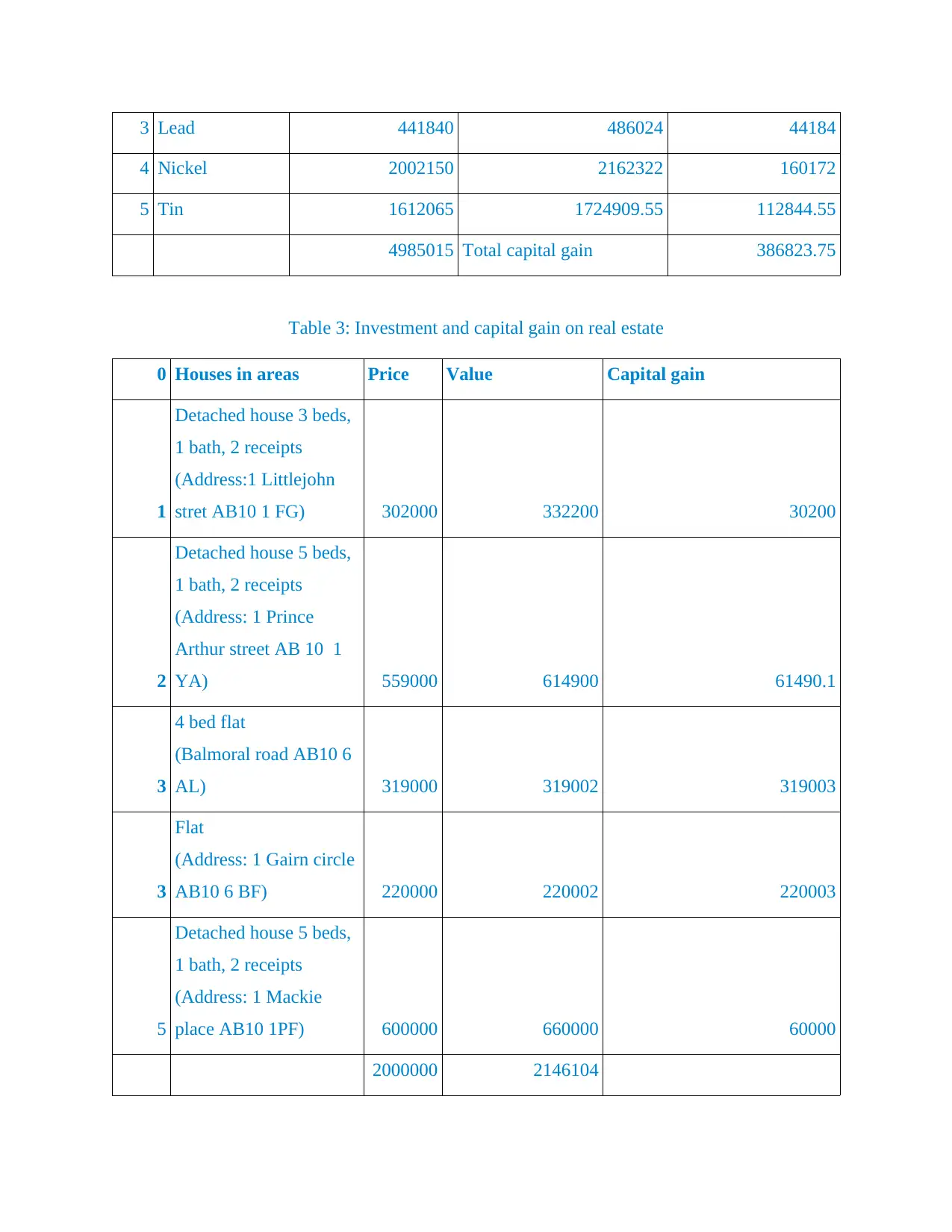
3 Lead 441840 486024 44184
4 Nickel 2002150 2162322 160172
5 Tin 1612065 1724909.55 112844.55
4985015 Total capital gain 386823.75
Table 3: Investment and capital gain on real estate
0 Houses in areas Price Value Capital gain
1
Detached house 3 beds,
1 bath, 2 receipts
(Address:1 Littlejohn
stret AB10 1 FG) 302000 332200 30200
2
Detached house 5 beds,
1 bath, 2 receipts
(Address: 1 Prince
Arthur street AB 10 1
YA) 559000 614900 61490.1
3
4 bed flat
(Balmoral road AB10 6
AL) 319000 319002 319003
3
Flat
(Address: 1 Gairn circle
AB10 6 BF) 220000 220002 220003
5
Detached house 5 beds,
1 bath, 2 receipts
(Address: 1 Mackie
place AB10 1PF) 600000 660000 60000
2000000 2146104
4 Nickel 2002150 2162322 160172
5 Tin 1612065 1724909.55 112844.55
4985015 Total capital gain 386823.75
Table 3: Investment and capital gain on real estate
0 Houses in areas Price Value Capital gain
1
Detached house 3 beds,
1 bath, 2 receipts
(Address:1 Littlejohn
stret AB10 1 FG) 302000 332200 30200
2
Detached house 5 beds,
1 bath, 2 receipts
(Address: 1 Prince
Arthur street AB 10 1
YA) 559000 614900 61490.1
3
4 bed flat
(Balmoral road AB10 6
AL) 319000 319002 319003
3
Flat
(Address: 1 Gairn circle
AB10 6 BF) 220000 220002 220003
5
Detached house 5 beds,
1 bath, 2 receipts
(Address: 1 Mackie
place AB10 1PF) 600000 660000 60000
2000000 2146104
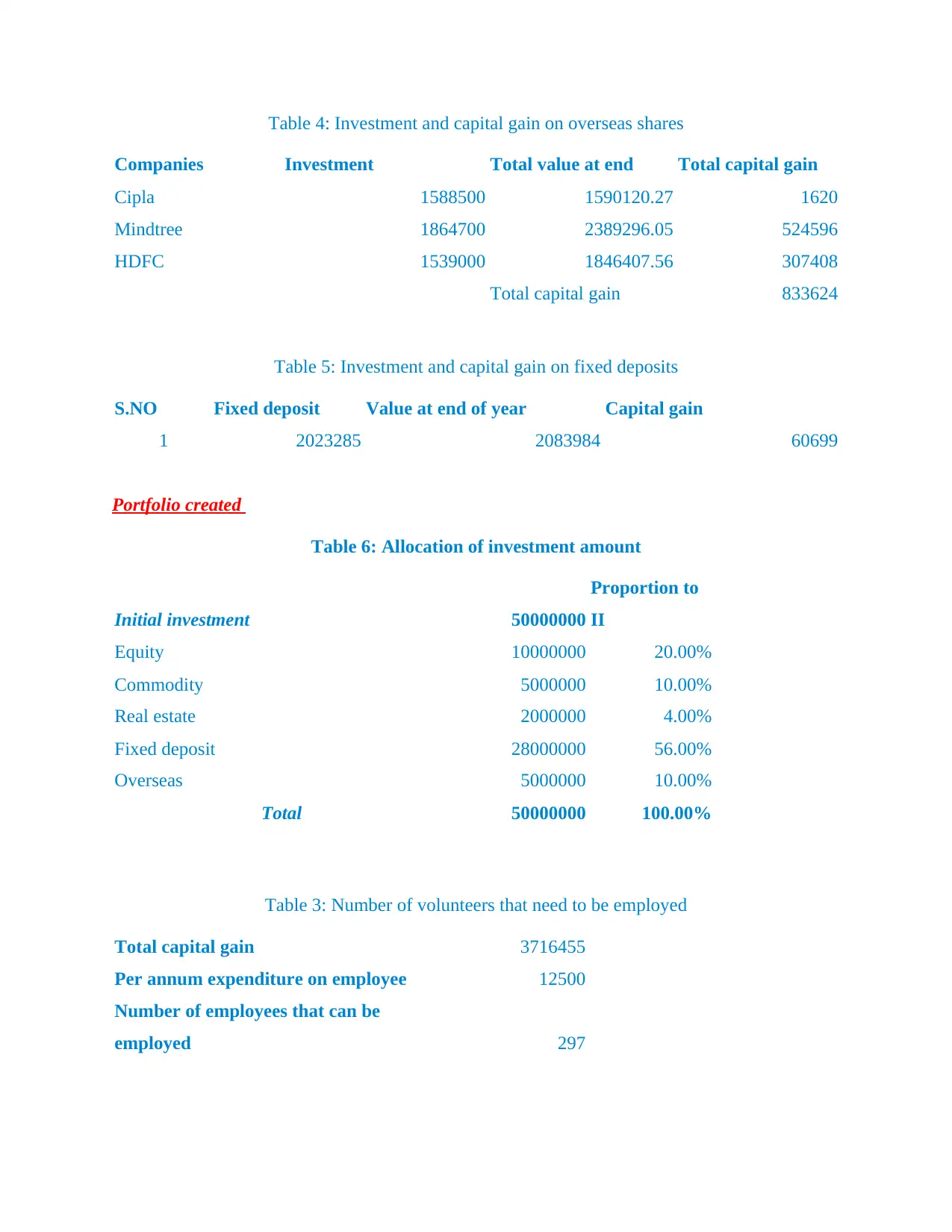
Table 4: Investment and capital gain on overseas shares
Companies Investment Total value at end Total capital gain
Cipla 1588500 1590120.27 1620
Mindtree 1864700 2389296.05 524596
HDFC 1539000 1846407.56 307408
Total capital gain 833624
Table 5: Investment and capital gain on fixed deposits
S.NO Fixed deposit Value at end of year Capital gain
1 2023285 2083984 60699
Portfolio created
Table 6: Allocation of investment amount
Initial investment 50000000
Proportion to
II
Equity 10000000 20.00%
Commodity 5000000 10.00%
Real estate 2000000 4.00%
Fixed deposit 28000000 56.00%
Overseas 5000000 10.00%
Total 50000000 100.00%
Table 3: Number of volunteers that need to be employed
Total capital gain 3716455
Per annum expenditure on employee 12500
Number of employees that can be
employed 297
Companies Investment Total value at end Total capital gain
Cipla 1588500 1590120.27 1620
Mindtree 1864700 2389296.05 524596
HDFC 1539000 1846407.56 307408
Total capital gain 833624
Table 5: Investment and capital gain on fixed deposits
S.NO Fixed deposit Value at end of year Capital gain
1 2023285 2083984 60699
Portfolio created
Table 6: Allocation of investment amount
Initial investment 50000000
Proportion to
II
Equity 10000000 20.00%
Commodity 5000000 10.00%
Real estate 2000000 4.00%
Fixed deposit 28000000 56.00%
Overseas 5000000 10.00%
Total 50000000 100.00%
Table 3: Number of volunteers that need to be employed
Total capital gain 3716455
Per annum expenditure on employee 12500
Number of employees that can be
employed 297
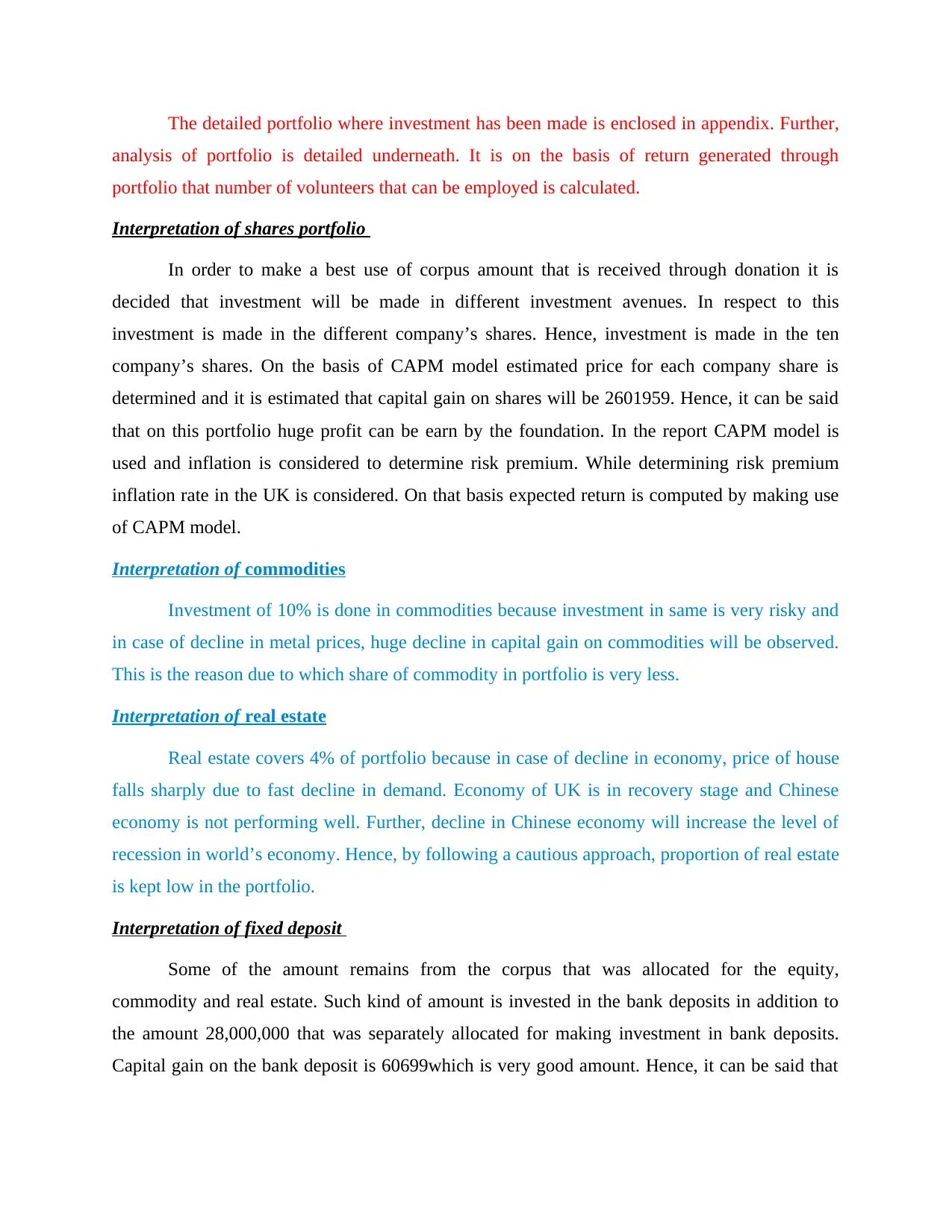
The detailed portfolio where investment has been made is enclosed in appendix. Further,
analysis of portfolio is detailed underneath. It is on the basis of return generated through
portfolio that number of volunteers that can be employed is calculated.
Interpretation of shares portfolio
In order to make a best use of corpus amount that is received through donation it is
decided that investment will be made in different investment avenues. In respect to this
investment is made in the different company’s shares. Hence, investment is made in the ten
company’s shares. On the basis of CAPM model estimated price for each company share is
determined and it is estimated that capital gain on shares will be 2601959. Hence, it can be said
that on this portfolio huge profit can be earn by the foundation. In the report CAPM model is
used and inflation is considered to determine risk premium. While determining risk premium
inflation rate in the UK is considered. On that basis expected return is computed by making use
of CAPM model.
Interpretation of commodities
Investment of 10% is done in commodities because investment in same is very risky and
in case of decline in metal prices, huge decline in capital gain on commodities will be observed.
This is the reason due to which share of commodity in portfolio is very less.
Interpretation of real estate
Real estate covers 4% of portfolio because in case of decline in economy, price of house
falls sharply due to fast decline in demand. Economy of UK is in recovery stage and Chinese
economy is not performing well. Further, decline in Chinese economy will increase the level of
recession in world’s economy. Hence, by following a cautious approach, proportion of real estate
is kept low in the portfolio.
Interpretation of fixed deposit
Some of the amount remains from the corpus that was allocated for the equity,
commodity and real estate. Such kind of amount is invested in the bank deposits in addition to
the amount 28,000,000 that was separately allocated for making investment in bank deposits.
Capital gain on the bank deposit is 60699which is very good amount. Hence, it can be said that
analysis of portfolio is detailed underneath. It is on the basis of return generated through
portfolio that number of volunteers that can be employed is calculated.
Interpretation of shares portfolio
In order to make a best use of corpus amount that is received through donation it is
decided that investment will be made in different investment avenues. In respect to this
investment is made in the different company’s shares. Hence, investment is made in the ten
company’s shares. On the basis of CAPM model estimated price for each company share is
determined and it is estimated that capital gain on shares will be 2601959. Hence, it can be said
that on this portfolio huge profit can be earn by the foundation. In the report CAPM model is
used and inflation is considered to determine risk premium. While determining risk premium
inflation rate in the UK is considered. On that basis expected return is computed by making use
of CAPM model.
Interpretation of commodities
Investment of 10% is done in commodities because investment in same is very risky and
in case of decline in metal prices, huge decline in capital gain on commodities will be observed.
This is the reason due to which share of commodity in portfolio is very less.
Interpretation of real estate
Real estate covers 4% of portfolio because in case of decline in economy, price of house
falls sharply due to fast decline in demand. Economy of UK is in recovery stage and Chinese
economy is not performing well. Further, decline in Chinese economy will increase the level of
recession in world’s economy. Hence, by following a cautious approach, proportion of real estate
is kept low in the portfolio.
Interpretation of fixed deposit
Some of the amount remains from the corpus that was allocated for the equity,
commodity and real estate. Such kind of amount is invested in the bank deposits in addition to
the amount 28,000,000 that was separately allocated for making investment in bank deposits.
Capital gain on the bank deposit is 60699which is very good amount. Hence, it can be said that
Paraphrase This Document
Need a fresh take? Get an instant paraphrase of this document with our AI Paraphraser
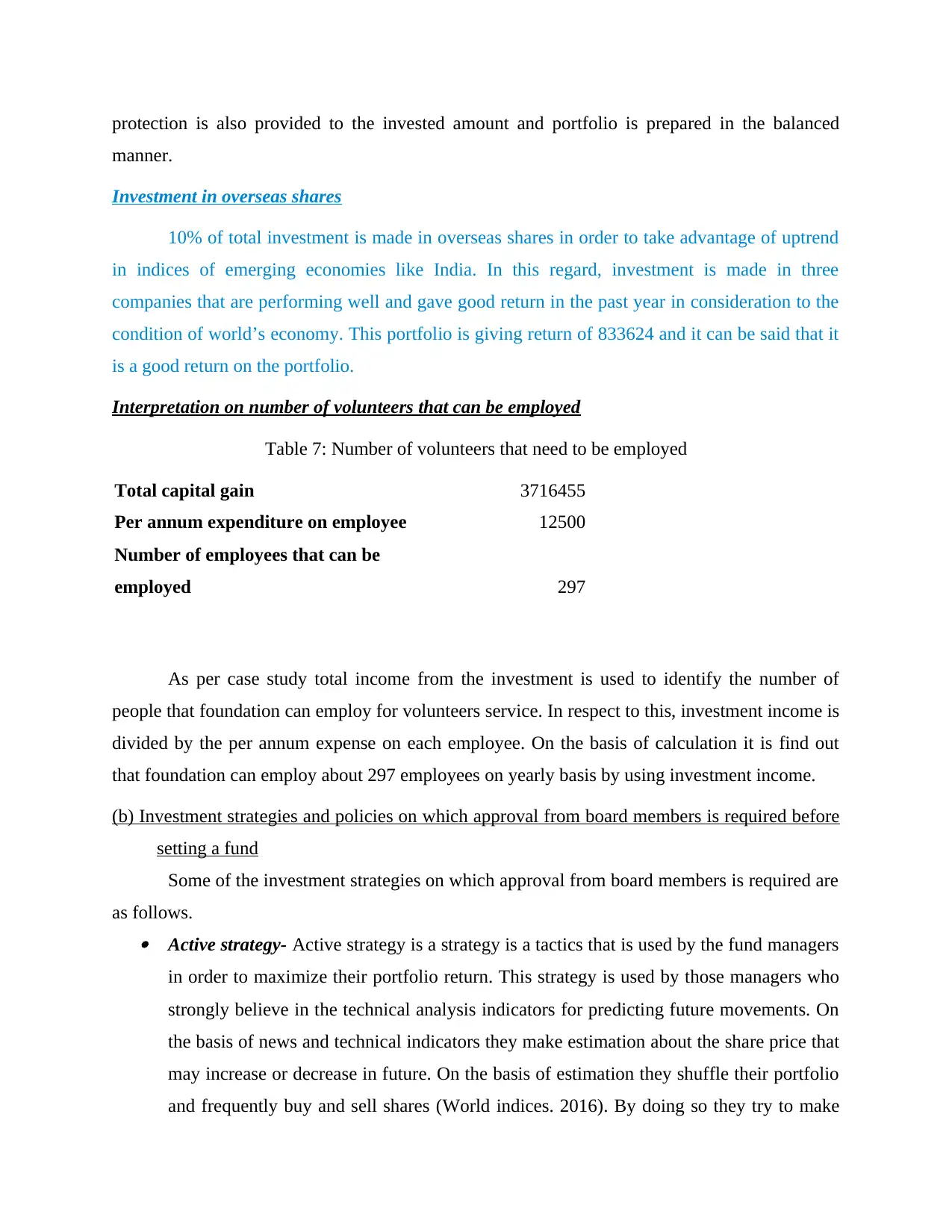
protection is also provided to the invested amount and portfolio is prepared in the balanced
manner.
Investment in overseas shares
10% of total investment is made in overseas shares in order to take advantage of uptrend
in indices of emerging economies like India. In this regard, investment is made in three
companies that are performing well and gave good return in the past year in consideration to the
condition of world’s economy. This portfolio is giving return of 833624 and it can be said that it
is a good return on the portfolio.
Interpretation on number of volunteers that can be employed
Table 7: Number of volunteers that need to be employed
Total capital gain 3716455
Per annum expenditure on employee 12500
Number of employees that can be
employed 297
As per case study total income from the investment is used to identify the number of
people that foundation can employ for volunteers service. In respect to this, investment income is
divided by the per annum expense on each employee. On the basis of calculation it is find out
that foundation can employ about 297 employees on yearly basis by using investment income.
(b) Investment strategies and policies on which approval from board members is required before
setting a fund
Some of the investment strategies on which approval from board members is required are
as follows. Active strategy- Active strategy is a strategy is a tactics that is used by the fund managers
in order to maximize their portfolio return. This strategy is used by those managers who
strongly believe in the technical analysis indicators for predicting future movements. On
the basis of news and technical indicators they make estimation about the share price that
may increase or decrease in future. On the basis of estimation they shuffle their portfolio
and frequently buy and sell shares (World indices. 2016). By doing so they try to make
manner.
Investment in overseas shares
10% of total investment is made in overseas shares in order to take advantage of uptrend
in indices of emerging economies like India. In this regard, investment is made in three
companies that are performing well and gave good return in the past year in consideration to the
condition of world’s economy. This portfolio is giving return of 833624 and it can be said that it
is a good return on the portfolio.
Interpretation on number of volunteers that can be employed
Table 7: Number of volunteers that need to be employed
Total capital gain 3716455
Per annum expenditure on employee 12500
Number of employees that can be
employed 297
As per case study total income from the investment is used to identify the number of
people that foundation can employ for volunteers service. In respect to this, investment income is
divided by the per annum expense on each employee. On the basis of calculation it is find out
that foundation can employ about 297 employees on yearly basis by using investment income.
(b) Investment strategies and policies on which approval from board members is required before
setting a fund
Some of the investment strategies on which approval from board members is required are
as follows. Active strategy- Active strategy is a strategy is a tactics that is used by the fund managers
in order to maximize their portfolio return. This strategy is used by those managers who
strongly believe in the technical analysis indicators for predicting future movements. On
the basis of news and technical indicators they make estimation about the share price that
may increase or decrease in future. On the basis of estimation they shuffle their portfolio
and frequently buy and sell shares (World indices. 2016). By doing so they try to make
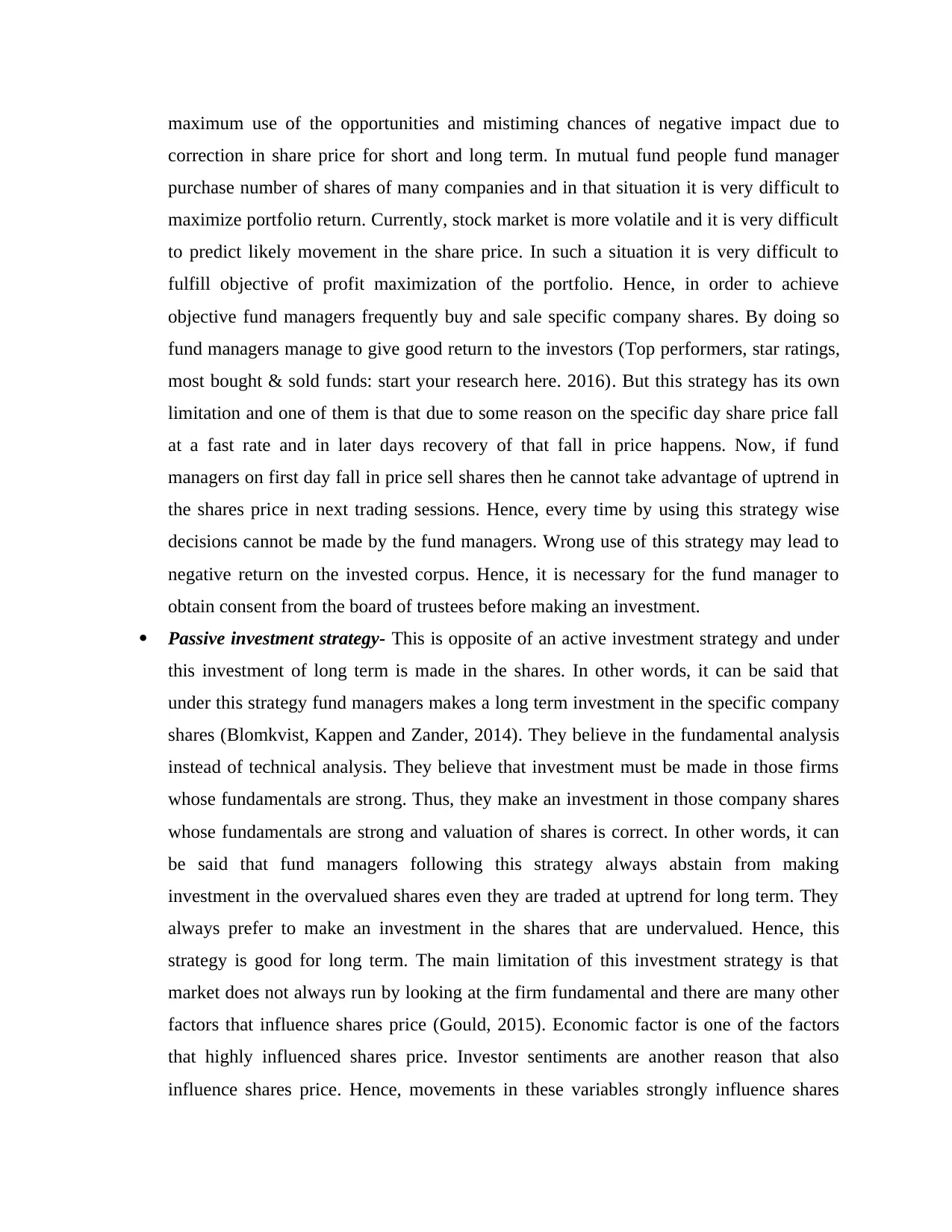
maximum use of the opportunities and mistiming chances of negative impact due to
correction in share price for short and long term. In mutual fund people fund manager
purchase number of shares of many companies and in that situation it is very difficult to
maximize portfolio return. Currently, stock market is more volatile and it is very difficult
to predict likely movement in the share price. In such a situation it is very difficult to
fulfill objective of profit maximization of the portfolio. Hence, in order to achieve
objective fund managers frequently buy and sale specific company shares. By doing so
fund managers manage to give good return to the investors (Top performers, star ratings,
most bought & sold funds: start your research here. 2016). But this strategy has its own
limitation and one of them is that due to some reason on the specific day share price fall
at a fast rate and in later days recovery of that fall in price happens. Now, if fund
managers on first day fall in price sell shares then he cannot take advantage of uptrend in
the shares price in next trading sessions. Hence, every time by using this strategy wise
decisions cannot be made by the fund managers. Wrong use of this strategy may lead to
negative return on the invested corpus. Hence, it is necessary for the fund manager to
obtain consent from the board of trustees before making an investment.
Passive investment strategy- This is opposite of an active investment strategy and under
this investment of long term is made in the shares. In other words, it can be said that
under this strategy fund managers makes a long term investment in the specific company
shares (Blomkvist, Kappen and Zander, 2014). They believe in the fundamental analysis
instead of technical analysis. They believe that investment must be made in those firms
whose fundamentals are strong. Thus, they make an investment in those company shares
whose fundamentals are strong and valuation of shares is correct. In other words, it can
be said that fund managers following this strategy always abstain from making
investment in the overvalued shares even they are traded at uptrend for long term. They
always prefer to make an investment in the shares that are undervalued. Hence, this
strategy is good for long term. The main limitation of this investment strategy is that
market does not always run by looking at the firm fundamental and there are many other
factors that influence shares price (Gould, 2015). Economic factor is one of the factors
that highly influenced shares price. Investor sentiments are another reason that also
influence shares price. Hence, movements in these variables strongly influence shares
correction in share price for short and long term. In mutual fund people fund manager
purchase number of shares of many companies and in that situation it is very difficult to
maximize portfolio return. Currently, stock market is more volatile and it is very difficult
to predict likely movement in the share price. In such a situation it is very difficult to
fulfill objective of profit maximization of the portfolio. Hence, in order to achieve
objective fund managers frequently buy and sale specific company shares. By doing so
fund managers manage to give good return to the investors (Top performers, star ratings,
most bought & sold funds: start your research here. 2016). But this strategy has its own
limitation and one of them is that due to some reason on the specific day share price fall
at a fast rate and in later days recovery of that fall in price happens. Now, if fund
managers on first day fall in price sell shares then he cannot take advantage of uptrend in
the shares price in next trading sessions. Hence, every time by using this strategy wise
decisions cannot be made by the fund managers. Wrong use of this strategy may lead to
negative return on the invested corpus. Hence, it is necessary for the fund manager to
obtain consent from the board of trustees before making an investment.
Passive investment strategy- This is opposite of an active investment strategy and under
this investment of long term is made in the shares. In other words, it can be said that
under this strategy fund managers makes a long term investment in the specific company
shares (Blomkvist, Kappen and Zander, 2014). They believe in the fundamental analysis
instead of technical analysis. They believe that investment must be made in those firms
whose fundamentals are strong. Thus, they make an investment in those company shares
whose fundamentals are strong and valuation of shares is correct. In other words, it can
be said that fund managers following this strategy always abstain from making
investment in the overvalued shares even they are traded at uptrend for long term. They
always prefer to make an investment in the shares that are undervalued. Hence, this
strategy is good for long term. The main limitation of this investment strategy is that
market does not always run by looking at the firm fundamental and there are many other
factors that influence shares price (Gould, 2015). Economic factor is one of the factors
that highly influenced shares price. Investor sentiments are another reason that also
influence shares price. Hence, movements in these variables strongly influence shares
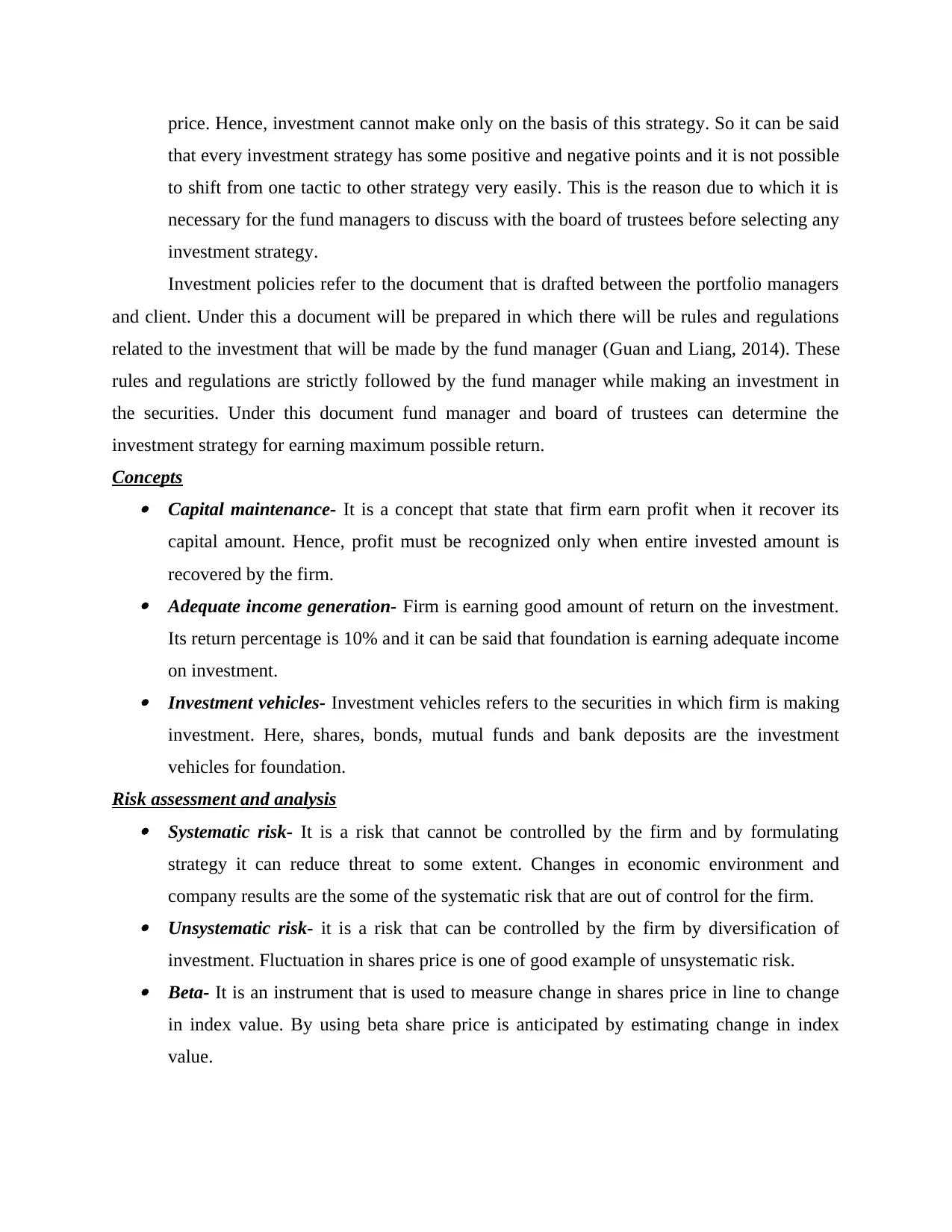
price. Hence, investment cannot make only on the basis of this strategy. So it can be said
that every investment strategy has some positive and negative points and it is not possible
to shift from one tactic to other strategy very easily. This is the reason due to which it is
necessary for the fund managers to discuss with the board of trustees before selecting any
investment strategy.
Investment policies refer to the document that is drafted between the portfolio managers
and client. Under this a document will be prepared in which there will be rules and regulations
related to the investment that will be made by the fund manager (Guan and Liang, 2014). These
rules and regulations are strictly followed by the fund manager while making an investment in
the securities. Under this document fund manager and board of trustees can determine the
investment strategy for earning maximum possible return.
Concepts Capital maintenance- It is a concept that state that firm earn profit when it recover its
capital amount. Hence, profit must be recognized only when entire invested amount is
recovered by the firm. Adequate income generation- Firm is earning good amount of return on the investment.
Its return percentage is 10% and it can be said that foundation is earning adequate income
on investment. Investment vehicles- Investment vehicles refers to the securities in which firm is making
investment. Here, shares, bonds, mutual funds and bank deposits are the investment
vehicles for foundation.
Risk assessment and analysis Systematic risk- It is a risk that cannot be controlled by the firm and by formulating
strategy it can reduce threat to some extent. Changes in economic environment and
company results are the some of the systematic risk that are out of control for the firm. Unsystematic risk- it is a risk that can be controlled by the firm by diversification of
investment. Fluctuation in shares price is one of good example of unsystematic risk. Beta- It is an instrument that is used to measure change in shares price in line to change
in index value. By using beta share price is anticipated by estimating change in index
value.
that every investment strategy has some positive and negative points and it is not possible
to shift from one tactic to other strategy very easily. This is the reason due to which it is
necessary for the fund managers to discuss with the board of trustees before selecting any
investment strategy.
Investment policies refer to the document that is drafted between the portfolio managers
and client. Under this a document will be prepared in which there will be rules and regulations
related to the investment that will be made by the fund manager (Guan and Liang, 2014). These
rules and regulations are strictly followed by the fund manager while making an investment in
the securities. Under this document fund manager and board of trustees can determine the
investment strategy for earning maximum possible return.
Concepts Capital maintenance- It is a concept that state that firm earn profit when it recover its
capital amount. Hence, profit must be recognized only when entire invested amount is
recovered by the firm. Adequate income generation- Firm is earning good amount of return on the investment.
Its return percentage is 10% and it can be said that foundation is earning adequate income
on investment. Investment vehicles- Investment vehicles refers to the securities in which firm is making
investment. Here, shares, bonds, mutual funds and bank deposits are the investment
vehicles for foundation.
Risk assessment and analysis Systematic risk- It is a risk that cannot be controlled by the firm and by formulating
strategy it can reduce threat to some extent. Changes in economic environment and
company results are the some of the systematic risk that are out of control for the firm. Unsystematic risk- it is a risk that can be controlled by the firm by diversification of
investment. Fluctuation in shares price is one of good example of unsystematic risk. Beta- It is an instrument that is used to measure change in shares price in line to change
in index value. By using beta share price is anticipated by estimating change in index
value.
Secure Best Marks with AI Grader
Need help grading? Try our AI Grader for instant feedback on your assignments.
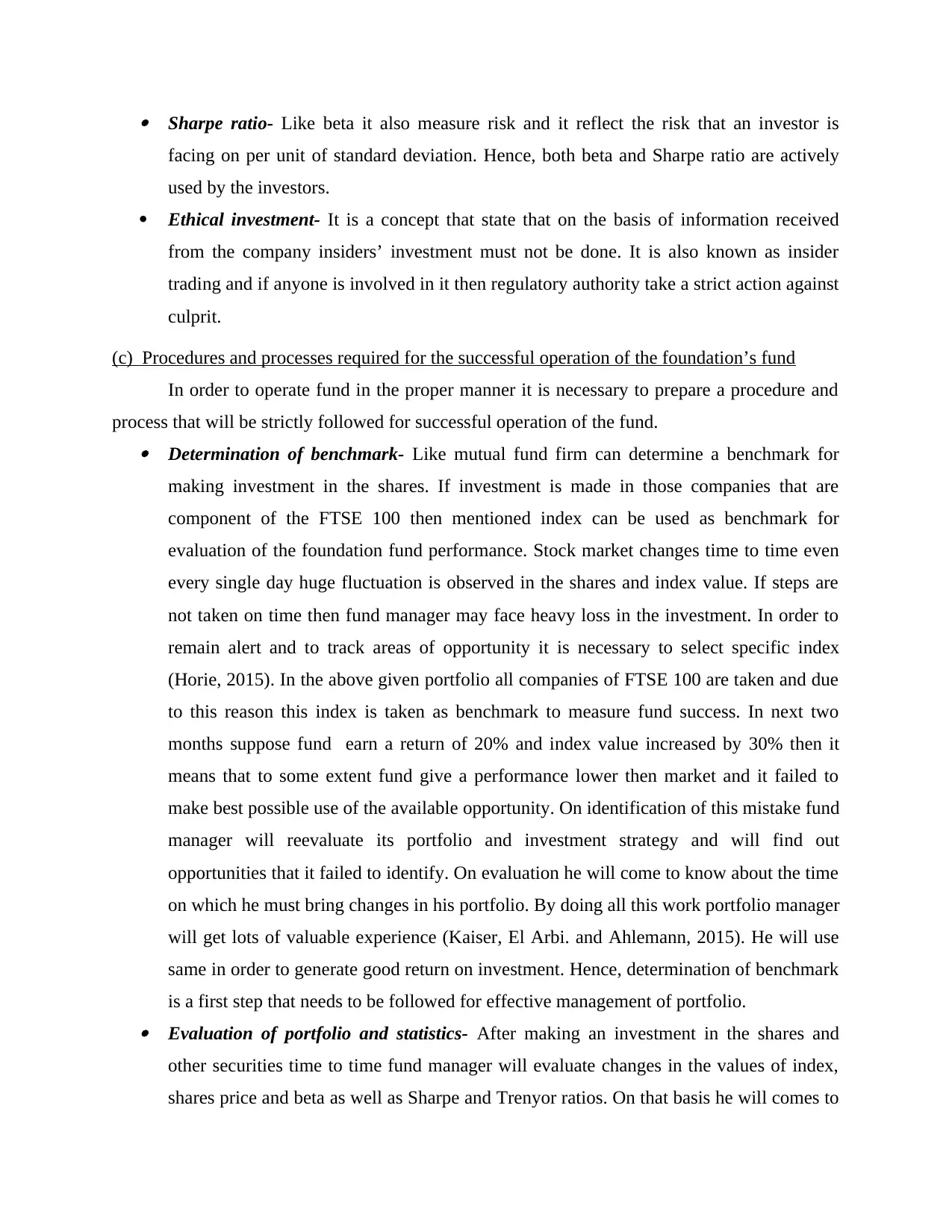
Sharpe ratio- Like beta it also measure risk and it reflect the risk that an investor is
facing on per unit of standard deviation. Hence, both beta and Sharpe ratio are actively
used by the investors.
Ethical investment- It is a concept that state that on the basis of information received
from the company insiders’ investment must not be done. It is also known as insider
trading and if anyone is involved in it then regulatory authority take a strict action against
culprit.
(c) Procedures and processes required for the successful operation of the foundation’s fund
In order to operate fund in the proper manner it is necessary to prepare a procedure and
process that will be strictly followed for successful operation of the fund. Determination of benchmark- Like mutual fund firm can determine a benchmark for
making investment in the shares. If investment is made in those companies that are
component of the FTSE 100 then mentioned index can be used as benchmark for
evaluation of the foundation fund performance. Stock market changes time to time even
every single day huge fluctuation is observed in the shares and index value. If steps are
not taken on time then fund manager may face heavy loss in the investment. In order to
remain alert and to track areas of opportunity it is necessary to select specific index
(Horie, 2015). In the above given portfolio all companies of FTSE 100 are taken and due
to this reason this index is taken as benchmark to measure fund success. In next two
months suppose fund earn a return of 20% and index value increased by 30% then it
means that to some extent fund give a performance lower then market and it failed to
make best possible use of the available opportunity. On identification of this mistake fund
manager will reevaluate its portfolio and investment strategy and will find out
opportunities that it failed to identify. On evaluation he will come to know about the time
on which he must bring changes in his portfolio. By doing all this work portfolio manager
will get lots of valuable experience (Kaiser, El Arbi. and Ahlemann, 2015). He will use
same in order to generate good return on investment. Hence, determination of benchmark
is a first step that needs to be followed for effective management of portfolio. Evaluation of portfolio and statistics- After making an investment in the shares and
other securities time to time fund manager will evaluate changes in the values of index,
shares price and beta as well as Sharpe and Trenyor ratios. On that basis he will comes to
facing on per unit of standard deviation. Hence, both beta and Sharpe ratio are actively
used by the investors.
Ethical investment- It is a concept that state that on the basis of information received
from the company insiders’ investment must not be done. It is also known as insider
trading and if anyone is involved in it then regulatory authority take a strict action against
culprit.
(c) Procedures and processes required for the successful operation of the foundation’s fund
In order to operate fund in the proper manner it is necessary to prepare a procedure and
process that will be strictly followed for successful operation of the fund. Determination of benchmark- Like mutual fund firm can determine a benchmark for
making investment in the shares. If investment is made in those companies that are
component of the FTSE 100 then mentioned index can be used as benchmark for
evaluation of the foundation fund performance. Stock market changes time to time even
every single day huge fluctuation is observed in the shares and index value. If steps are
not taken on time then fund manager may face heavy loss in the investment. In order to
remain alert and to track areas of opportunity it is necessary to select specific index
(Horie, 2015). In the above given portfolio all companies of FTSE 100 are taken and due
to this reason this index is taken as benchmark to measure fund success. In next two
months suppose fund earn a return of 20% and index value increased by 30% then it
means that to some extent fund give a performance lower then market and it failed to
make best possible use of the available opportunity. On identification of this mistake fund
manager will reevaluate its portfolio and investment strategy and will find out
opportunities that it failed to identify. On evaluation he will come to know about the time
on which he must bring changes in his portfolio. By doing all this work portfolio manager
will get lots of valuable experience (Kaiser, El Arbi. and Ahlemann, 2015). He will use
same in order to generate good return on investment. Hence, determination of benchmark
is a first step that needs to be followed for effective management of portfolio. Evaluation of portfolio and statistics- After making an investment in the shares and
other securities time to time fund manager will evaluate changes in the values of index,
shares price and beta as well as Sharpe and Trenyor ratios. On that basis he will comes to
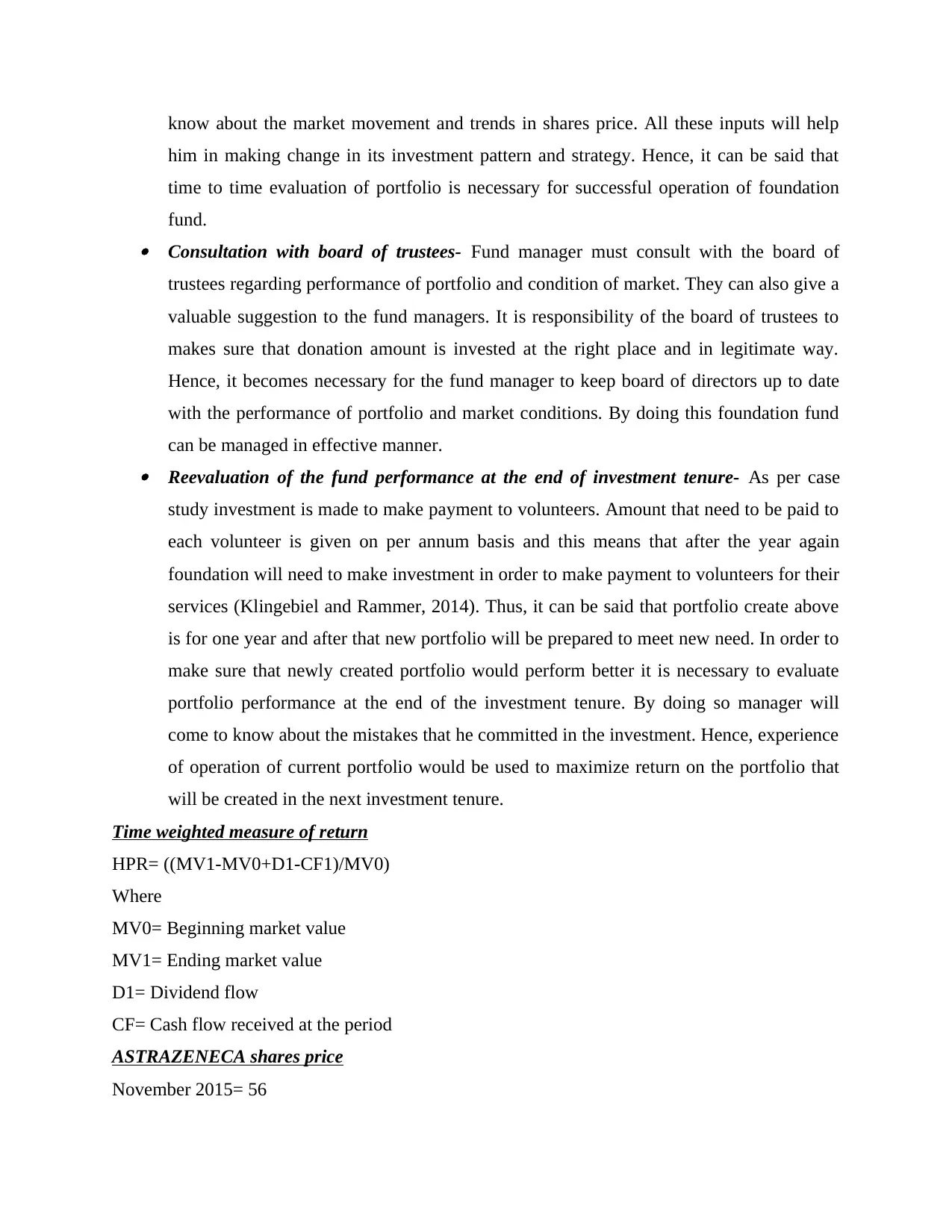
know about the market movement and trends in shares price. All these inputs will help
him in making change in its investment pattern and strategy. Hence, it can be said that
time to time evaluation of portfolio is necessary for successful operation of foundation
fund. Consultation with board of trustees- Fund manager must consult with the board of
trustees regarding performance of portfolio and condition of market. They can also give a
valuable suggestion to the fund managers. It is responsibility of the board of trustees to
makes sure that donation amount is invested at the right place and in legitimate way.
Hence, it becomes necessary for the fund manager to keep board of directors up to date
with the performance of portfolio and market conditions. By doing this foundation fund
can be managed in effective manner. Reevaluation of the fund performance at the end of investment tenure- As per case
study investment is made to make payment to volunteers. Amount that need to be paid to
each volunteer is given on per annum basis and this means that after the year again
foundation will need to make investment in order to make payment to volunteers for their
services (Klingebiel and Rammer, 2014). Thus, it can be said that portfolio create above
is for one year and after that new portfolio will be prepared to meet new need. In order to
make sure that newly created portfolio would perform better it is necessary to evaluate
portfolio performance at the end of the investment tenure. By doing so manager will
come to know about the mistakes that he committed in the investment. Hence, experience
of operation of current portfolio would be used to maximize return on the portfolio that
will be created in the next investment tenure.
Time weighted measure of return
HPR= ((MV1-MV0+D1-CF1)/MV0)
Where
MV0= Beginning market value
MV1= Ending market value
D1= Dividend flow
CF= Cash flow received at the period
ASTRAZENECA shares price
November 2015= 56
him in making change in its investment pattern and strategy. Hence, it can be said that
time to time evaluation of portfolio is necessary for successful operation of foundation
fund. Consultation with board of trustees- Fund manager must consult with the board of
trustees regarding performance of portfolio and condition of market. They can also give a
valuable suggestion to the fund managers. It is responsibility of the board of trustees to
makes sure that donation amount is invested at the right place and in legitimate way.
Hence, it becomes necessary for the fund manager to keep board of directors up to date
with the performance of portfolio and market conditions. By doing this foundation fund
can be managed in effective manner. Reevaluation of the fund performance at the end of investment tenure- As per case
study investment is made to make payment to volunteers. Amount that need to be paid to
each volunteer is given on per annum basis and this means that after the year again
foundation will need to make investment in order to make payment to volunteers for their
services (Klingebiel and Rammer, 2014). Thus, it can be said that portfolio create above
is for one year and after that new portfolio will be prepared to meet new need. In order to
make sure that newly created portfolio would perform better it is necessary to evaluate
portfolio performance at the end of the investment tenure. By doing so manager will
come to know about the mistakes that he committed in the investment. Hence, experience
of operation of current portfolio would be used to maximize return on the portfolio that
will be created in the next investment tenure.
Time weighted measure of return
HPR= ((MV1-MV0+D1-CF1)/MV0)
Where
MV0= Beginning market value
MV1= Ending market value
D1= Dividend flow
CF= Cash flow received at the period
ASTRAZENECA shares price
November 2015= 56
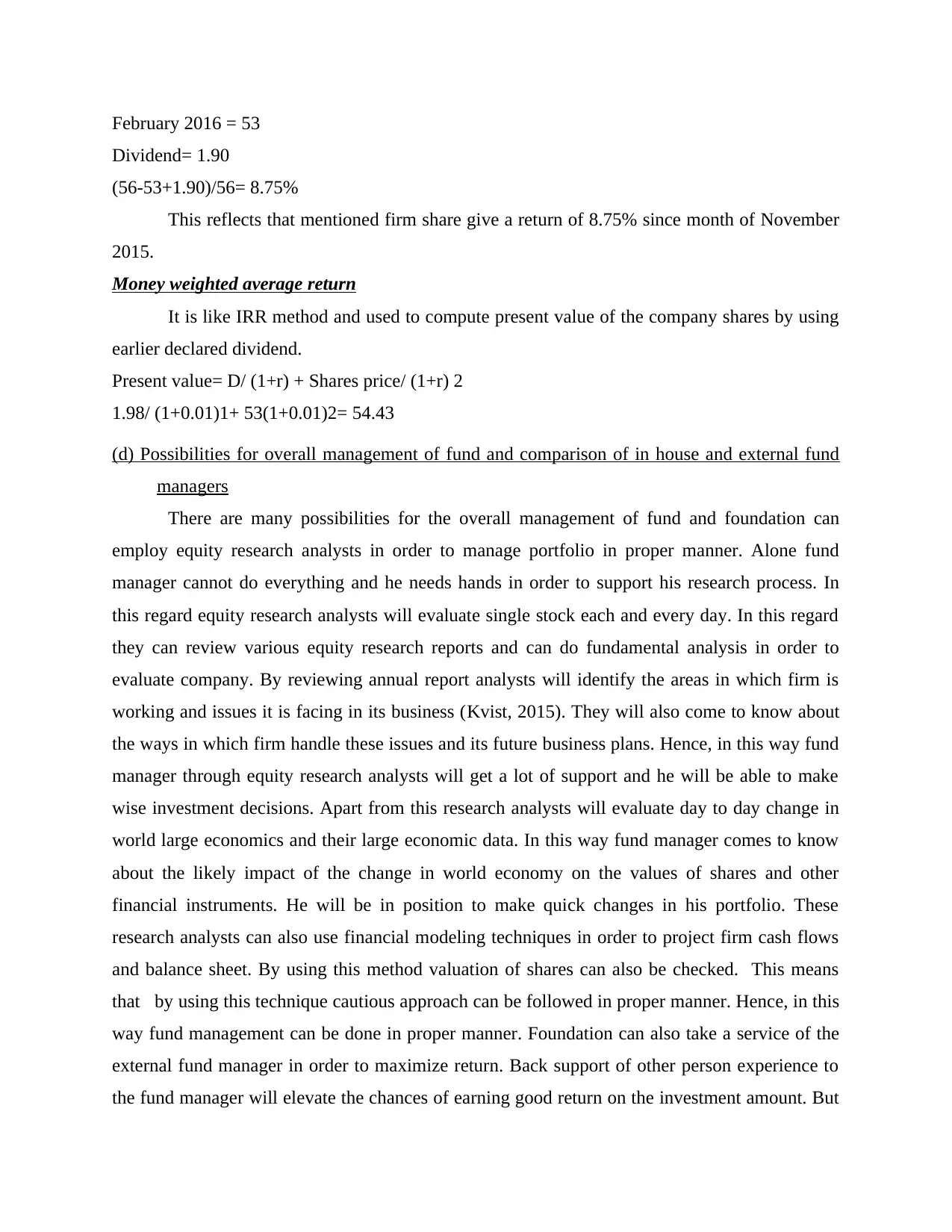
February 2016 = 53
Dividend= 1.90
(56-53+1.90)/56= 8.75%
This reflects that mentioned firm share give a return of 8.75% since month of November
2015.
Money weighted average return
It is like IRR method and used to compute present value of the company shares by using
earlier declared dividend.
Present value= D/ (1+r) + Shares price/ (1+r) 2
1.98/ (1+0.01)1+ 53(1+0.01)2= 54.43
(d) Possibilities for overall management of fund and comparison of in house and external fund
managers
There are many possibilities for the overall management of fund and foundation can
employ equity research analysts in order to manage portfolio in proper manner. Alone fund
manager cannot do everything and he needs hands in order to support his research process. In
this regard equity research analysts will evaluate single stock each and every day. In this regard
they can review various equity research reports and can do fundamental analysis in order to
evaluate company. By reviewing annual report analysts will identify the areas in which firm is
working and issues it is facing in its business (Kvist, 2015). They will also come to know about
the ways in which firm handle these issues and its future business plans. Hence, in this way fund
manager through equity research analysts will get a lot of support and he will be able to make
wise investment decisions. Apart from this research analysts will evaluate day to day change in
world large economics and their large economic data. In this way fund manager comes to know
about the likely impact of the change in world economy on the values of shares and other
financial instruments. He will be in position to make quick changes in his portfolio. These
research analysts can also use financial modeling techniques in order to project firm cash flows
and balance sheet. By using this method valuation of shares can also be checked. This means
that by using this technique cautious approach can be followed in proper manner. Hence, in this
way fund management can be done in proper manner. Foundation can also take a service of the
external fund manager in order to maximize return. Back support of other person experience to
the fund manager will elevate the chances of earning good return on the investment amount. But
Dividend= 1.90
(56-53+1.90)/56= 8.75%
This reflects that mentioned firm share give a return of 8.75% since month of November
2015.
Money weighted average return
It is like IRR method and used to compute present value of the company shares by using
earlier declared dividend.
Present value= D/ (1+r) + Shares price/ (1+r) 2
1.98/ (1+0.01)1+ 53(1+0.01)2= 54.43
(d) Possibilities for overall management of fund and comparison of in house and external fund
managers
There are many possibilities for the overall management of fund and foundation can
employ equity research analysts in order to manage portfolio in proper manner. Alone fund
manager cannot do everything and he needs hands in order to support his research process. In
this regard equity research analysts will evaluate single stock each and every day. In this regard
they can review various equity research reports and can do fundamental analysis in order to
evaluate company. By reviewing annual report analysts will identify the areas in which firm is
working and issues it is facing in its business (Kvist, 2015). They will also come to know about
the ways in which firm handle these issues and its future business plans. Hence, in this way fund
manager through equity research analysts will get a lot of support and he will be able to make
wise investment decisions. Apart from this research analysts will evaluate day to day change in
world large economics and their large economic data. In this way fund manager comes to know
about the likely impact of the change in world economy on the values of shares and other
financial instruments. He will be in position to make quick changes in his portfolio. These
research analysts can also use financial modeling techniques in order to project firm cash flows
and balance sheet. By using this method valuation of shares can also be checked. This means
that by using this technique cautious approach can be followed in proper manner. Hence, in this
way fund management can be done in proper manner. Foundation can also take a service of the
external fund manager in order to maximize return. Back support of other person experience to
the fund manager will elevate the chances of earning good return on the investment amount. But
Paraphrase This Document
Need a fresh take? Get an instant paraphrase of this document with our AI Paraphraser
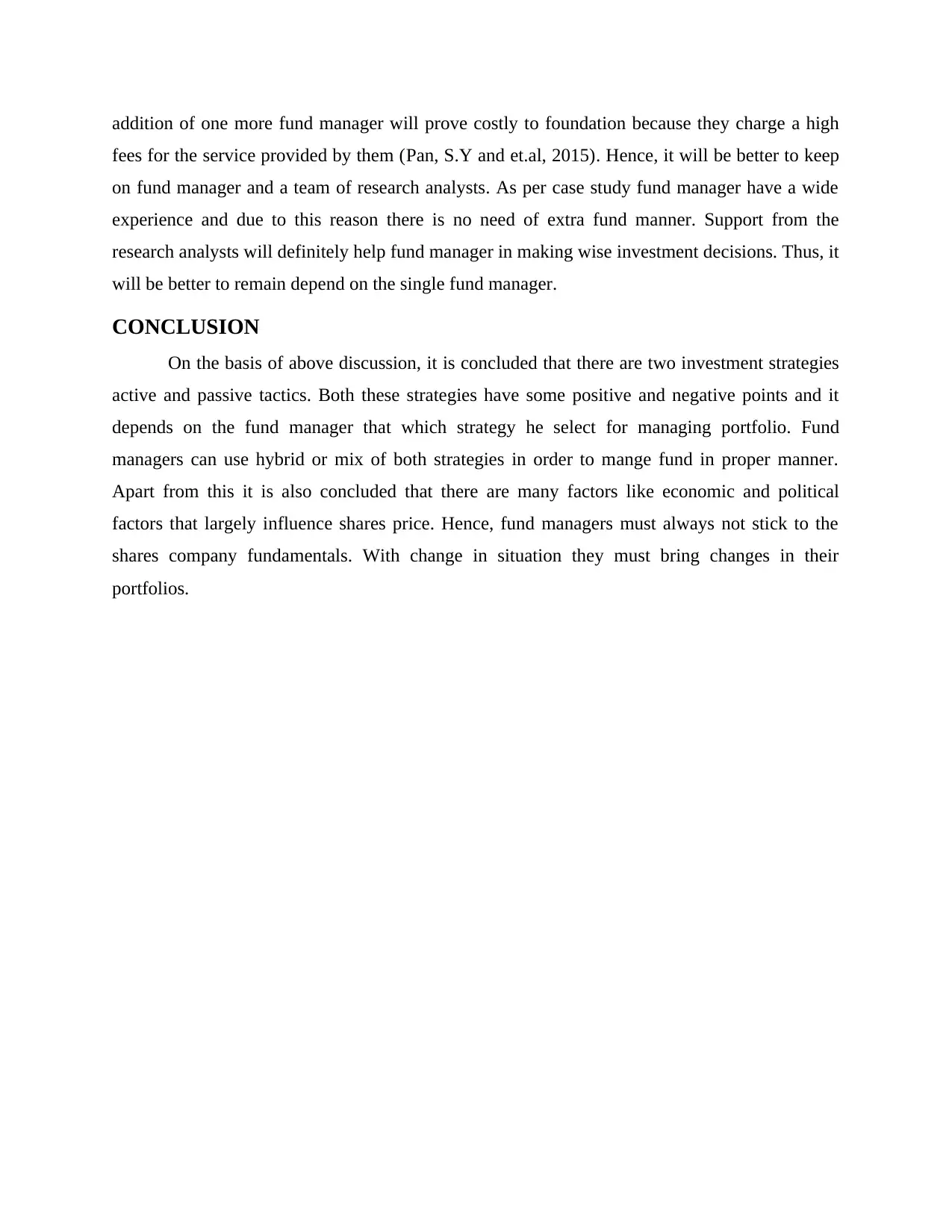
addition of one more fund manager will prove costly to foundation because they charge a high
fees for the service provided by them (Pan, S.Y and et.al, 2015). Hence, it will be better to keep
on fund manager and a team of research analysts. As per case study fund manager have a wide
experience and due to this reason there is no need of extra fund manner. Support from the
research analysts will definitely help fund manager in making wise investment decisions. Thus, it
will be better to remain depend on the single fund manager.
CONCLUSION
On the basis of above discussion, it is concluded that there are two investment strategies
active and passive tactics. Both these strategies have some positive and negative points and it
depends on the fund manager that which strategy he select for managing portfolio. Fund
managers can use hybrid or mix of both strategies in order to mange fund in proper manner.
Apart from this it is also concluded that there are many factors like economic and political
factors that largely influence shares price. Hence, fund managers must always not stick to the
shares company fundamentals. With change in situation they must bring changes in their
portfolios.
fees for the service provided by them (Pan, S.Y and et.al, 2015). Hence, it will be better to keep
on fund manager and a team of research analysts. As per case study fund manager have a wide
experience and due to this reason there is no need of extra fund manner. Support from the
research analysts will definitely help fund manager in making wise investment decisions. Thus, it
will be better to remain depend on the single fund manager.
CONCLUSION
On the basis of above discussion, it is concluded that there are two investment strategies
active and passive tactics. Both these strategies have some positive and negative points and it
depends on the fund manager that which strategy he select for managing portfolio. Fund
managers can use hybrid or mix of both strategies in order to mange fund in proper manner.
Apart from this it is also concluded that there are many factors like economic and political
factors that largely influence shares price. Hence, fund managers must always not stick to the
shares company fundamentals. With change in situation they must bring changes in their
portfolios.
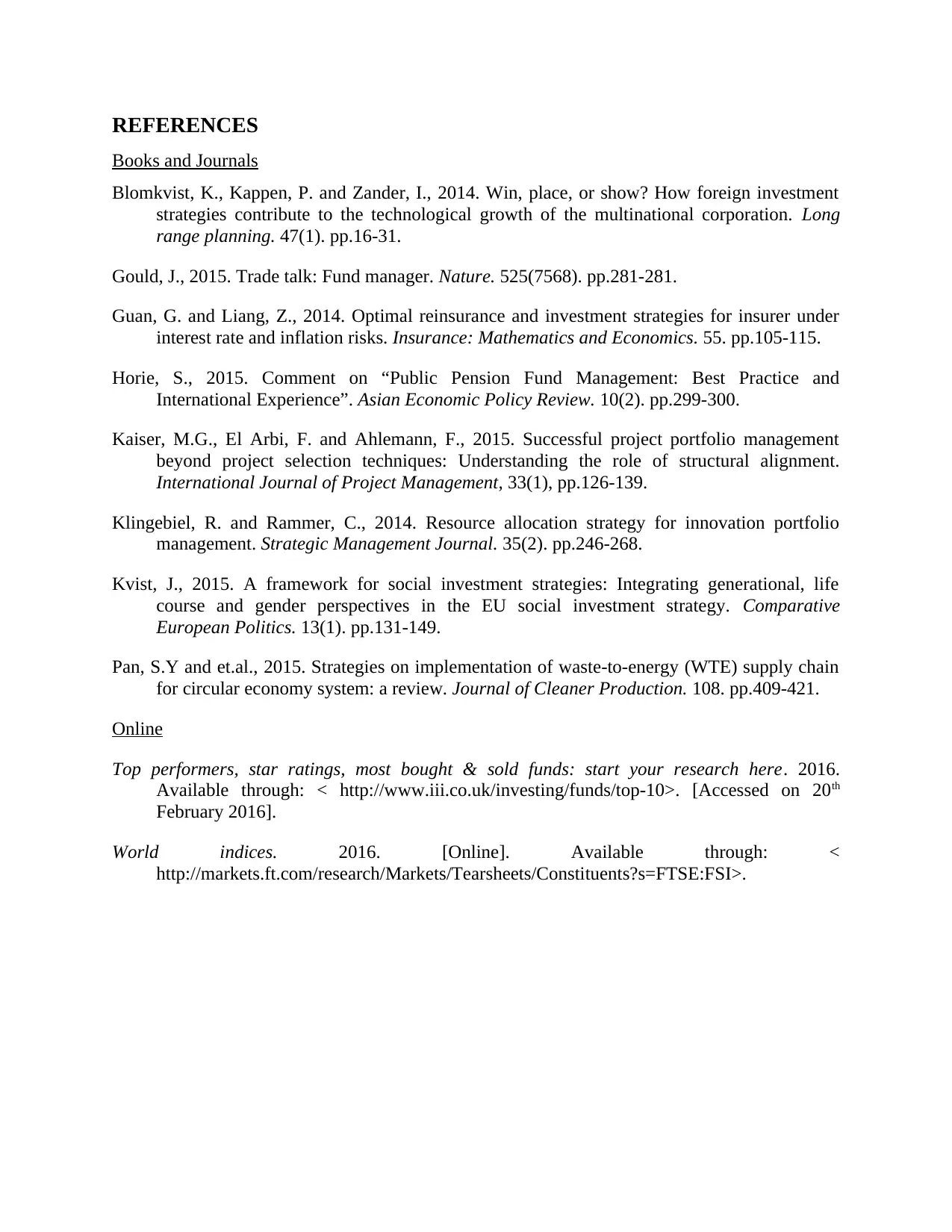
REFERENCES
Books and Journals
Blomkvist, K., Kappen, P. and Zander, I., 2014. Win, place, or show? How foreign investment
strategies contribute to the technological growth of the multinational corporation. Long
range planning. 47(1). pp.16-31.
Gould, J., 2015. Trade talk: Fund manager. Nature. 525(7568). pp.281-281.
Guan, G. and Liang, Z., 2014. Optimal reinsurance and investment strategies for insurer under
interest rate and inflation risks. Insurance: Mathematics and Economics. 55. pp.105-115.
Horie, S., 2015. Comment on “Public Pension Fund Management: Best Practice and
International Experience”. Asian Economic Policy Review. 10(2). pp.299-300.
Kaiser, M.G., El Arbi, F. and Ahlemann, F., 2015. Successful project portfolio management
beyond project selection techniques: Understanding the role of structural alignment.
International Journal of Project Management, 33(1), pp.126-139.
Klingebiel, R. and Rammer, C., 2014. Resource allocation strategy for innovation portfolio
management. Strategic Management Journal. 35(2). pp.246-268.
Kvist, J., 2015. A framework for social investment strategies: Integrating generational, life
course and gender perspectives in the EU social investment strategy. Comparative
European Politics. 13(1). pp.131-149.
Pan, S.Y and et.al., 2015. Strategies on implementation of waste-to-energy (WTE) supply chain
for circular economy system: a review. Journal of Cleaner Production. 108. pp.409-421.
Online
Top performers, star ratings, most bought & sold funds: start your research here. 2016.
Available through: < http://www.iii.co.uk/investing/funds/top-10>. [Accessed on 20th
February 2016].
World indices. 2016. [Online]. Available through: <
http://markets.ft.com/research/Markets/Tearsheets/Constituents?s=FTSE:FSI>.
Books and Journals
Blomkvist, K., Kappen, P. and Zander, I., 2014. Win, place, or show? How foreign investment
strategies contribute to the technological growth of the multinational corporation. Long
range planning. 47(1). pp.16-31.
Gould, J., 2015. Trade talk: Fund manager. Nature. 525(7568). pp.281-281.
Guan, G. and Liang, Z., 2014. Optimal reinsurance and investment strategies for insurer under
interest rate and inflation risks. Insurance: Mathematics and Economics. 55. pp.105-115.
Horie, S., 2015. Comment on “Public Pension Fund Management: Best Practice and
International Experience”. Asian Economic Policy Review. 10(2). pp.299-300.
Kaiser, M.G., El Arbi, F. and Ahlemann, F., 2015. Successful project portfolio management
beyond project selection techniques: Understanding the role of structural alignment.
International Journal of Project Management, 33(1), pp.126-139.
Klingebiel, R. and Rammer, C., 2014. Resource allocation strategy for innovation portfolio
management. Strategic Management Journal. 35(2). pp.246-268.
Kvist, J., 2015. A framework for social investment strategies: Integrating generational, life
course and gender perspectives in the EU social investment strategy. Comparative
European Politics. 13(1). pp.131-149.
Pan, S.Y and et.al., 2015. Strategies on implementation of waste-to-energy (WTE) supply chain
for circular economy system: a review. Journal of Cleaner Production. 108. pp.409-421.
Online
Top performers, star ratings, most bought & sold funds: start your research here. 2016.
Available through: < http://www.iii.co.uk/investing/funds/top-10>. [Accessed on 20th
February 2016].
World indices. 2016. [Online]. Available through: <
http://markets.ft.com/research/Markets/Tearsheets/Constituents?s=FTSE:FSI>.
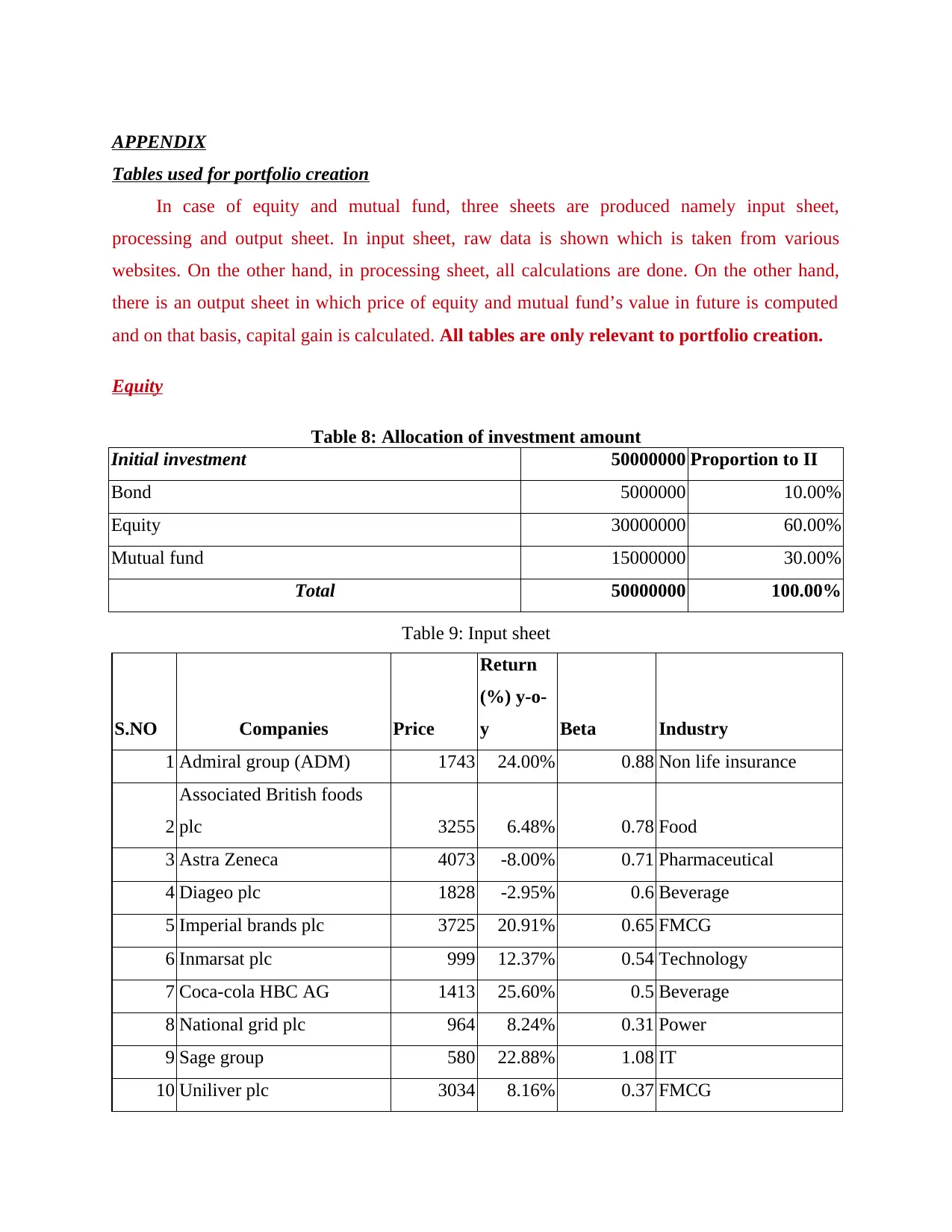
APPENDIX
Tables used for portfolio creation
In case of equity and mutual fund, three sheets are produced namely input sheet,
processing and output sheet. In input sheet, raw data is shown which is taken from various
websites. On the other hand, in processing sheet, all calculations are done. On the other hand,
there is an output sheet in which price of equity and mutual fund’s value in future is computed
and on that basis, capital gain is calculated. All tables are only relevant to portfolio creation.
Equity
Table 8: Allocation of investment amount
Initial investment 50000000 Proportion to II
Bond 5000000 10.00%
Equity 30000000 60.00%
Mutual fund 15000000 30.00%
Total 50000000 100.00%
Table 9: Input sheet
S.NO Companies Price
Return
(%) y-o-
y Beta Industry
1 Admiral group (ADM) 1743 24.00% 0.88 Non life insurance
2
Associated British foods
plc 3255 6.48% 0.78 Food
3 Astra Zeneca 4073 -8.00% 0.71 Pharmaceutical
4 Diageo plc 1828 -2.95% 0.6 Beverage
5 Imperial brands plc 3725 20.91% 0.65 FMCG
6 Inmarsat plc 999 12.37% 0.54 Technology
7 Coca-cola HBC AG 1413 25.60% 0.5 Beverage
8 National grid plc 964 8.24% 0.31 Power
9 Sage group 580 22.88% 1.08 IT
10 Uniliver plc 3034 8.16% 0.37 FMCG
Tables used for portfolio creation
In case of equity and mutual fund, three sheets are produced namely input sheet,
processing and output sheet. In input sheet, raw data is shown which is taken from various
websites. On the other hand, in processing sheet, all calculations are done. On the other hand,
there is an output sheet in which price of equity and mutual fund’s value in future is computed
and on that basis, capital gain is calculated. All tables are only relevant to portfolio creation.
Equity
Table 8: Allocation of investment amount
Initial investment 50000000 Proportion to II
Bond 5000000 10.00%
Equity 30000000 60.00%
Mutual fund 15000000 30.00%
Total 50000000 100.00%
Table 9: Input sheet
S.NO Companies Price
Return
(%) y-o-
y Beta Industry
1 Admiral group (ADM) 1743 24.00% 0.88 Non life insurance
2
Associated British foods
plc 3255 6.48% 0.78 Food
3 Astra Zeneca 4073 -8.00% 0.71 Pharmaceutical
4 Diageo plc 1828 -2.95% 0.6 Beverage
5 Imperial brands plc 3725 20.91% 0.65 FMCG
6 Inmarsat plc 999 12.37% 0.54 Technology
7 Coca-cola HBC AG 1413 25.60% 0.5 Beverage
8 National grid plc 964 8.24% 0.31 Power
9 Sage group 580 22.88% 1.08 IT
10 Uniliver plc 3034 8.16% 0.37 FMCG
Secure Best Marks with AI Grader
Need help grading? Try our AI Grader for instant feedback on your assignments.
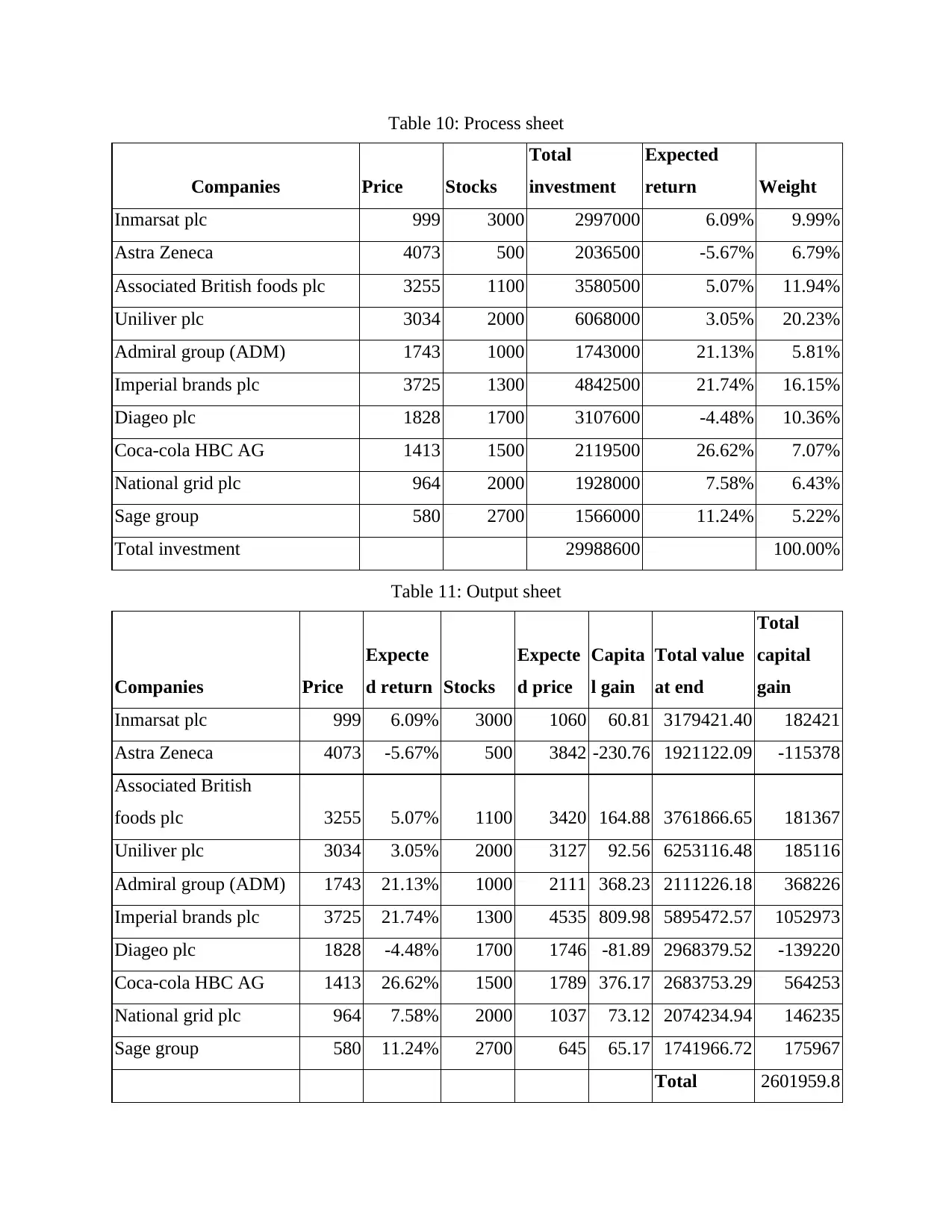
Table 10: Process sheet
Companies Price Stocks
Total
investment
Expected
return Weight
Inmarsat plc 999 3000 2997000 6.09% 9.99%
Astra Zeneca 4073 500 2036500 -5.67% 6.79%
Associated British foods plc 3255 1100 3580500 5.07% 11.94%
Uniliver plc 3034 2000 6068000 3.05% 20.23%
Admiral group (ADM) 1743 1000 1743000 21.13% 5.81%
Imperial brands plc 3725 1300 4842500 21.74% 16.15%
Diageo plc 1828 1700 3107600 -4.48% 10.36%
Coca-cola HBC AG 1413 1500 2119500 26.62% 7.07%
National grid plc 964 2000 1928000 7.58% 6.43%
Sage group 580 2700 1566000 11.24% 5.22%
Total investment 29988600 100.00%
Table 11: Output sheet
Companies Price
Expecte
d return Stocks
Expecte
d price
Capita
l gain
Total value
at end
Total
capital
gain
Inmarsat plc 999 6.09% 3000 1060 60.81 3179421.40 182421
Astra Zeneca 4073 -5.67% 500 3842 -230.76 1921122.09 -115378
Associated British
foods plc 3255 5.07% 1100 3420 164.88 3761866.65 181367
Uniliver plc 3034 3.05% 2000 3127 92.56 6253116.48 185116
Admiral group (ADM) 1743 21.13% 1000 2111 368.23 2111226.18 368226
Imperial brands plc 3725 21.74% 1300 4535 809.98 5895472.57 1052973
Diageo plc 1828 -4.48% 1700 1746 -81.89 2968379.52 -139220
Coca-cola HBC AG 1413 26.62% 1500 1789 376.17 2683753.29 564253
National grid plc 964 7.58% 2000 1037 73.12 2074234.94 146235
Sage group 580 11.24% 2700 645 65.17 1741966.72 175967
Total 2601959.8
Companies Price Stocks
Total
investment
Expected
return Weight
Inmarsat plc 999 3000 2997000 6.09% 9.99%
Astra Zeneca 4073 500 2036500 -5.67% 6.79%
Associated British foods plc 3255 1100 3580500 5.07% 11.94%
Uniliver plc 3034 2000 6068000 3.05% 20.23%
Admiral group (ADM) 1743 1000 1743000 21.13% 5.81%
Imperial brands plc 3725 1300 4842500 21.74% 16.15%
Diageo plc 1828 1700 3107600 -4.48% 10.36%
Coca-cola HBC AG 1413 1500 2119500 26.62% 7.07%
National grid plc 964 2000 1928000 7.58% 6.43%
Sage group 580 2700 1566000 11.24% 5.22%
Total investment 29988600 100.00%
Table 11: Output sheet
Companies Price
Expecte
d return Stocks
Expecte
d price
Capita
l gain
Total value
at end
Total
capital
gain
Inmarsat plc 999 6.09% 3000 1060 60.81 3179421.40 182421
Astra Zeneca 4073 -5.67% 500 3842 -230.76 1921122.09 -115378
Associated British
foods plc 3255 5.07% 1100 3420 164.88 3761866.65 181367
Uniliver plc 3034 3.05% 2000 3127 92.56 6253116.48 185116
Admiral group (ADM) 1743 21.13% 1000 2111 368.23 2111226.18 368226
Imperial brands plc 3725 21.74% 1300 4535 809.98 5895472.57 1052973
Diageo plc 1828 -4.48% 1700 1746 -81.89 2968379.52 -139220
Coca-cola HBC AG 1413 26.62% 1500 1789 376.17 2683753.29 564253
National grid plc 964 7.58% 2000 1037 73.12 2074234.94 146235
Sage group 580 11.24% 2700 645 65.17 1741966.72 175967
Total 2601959.8
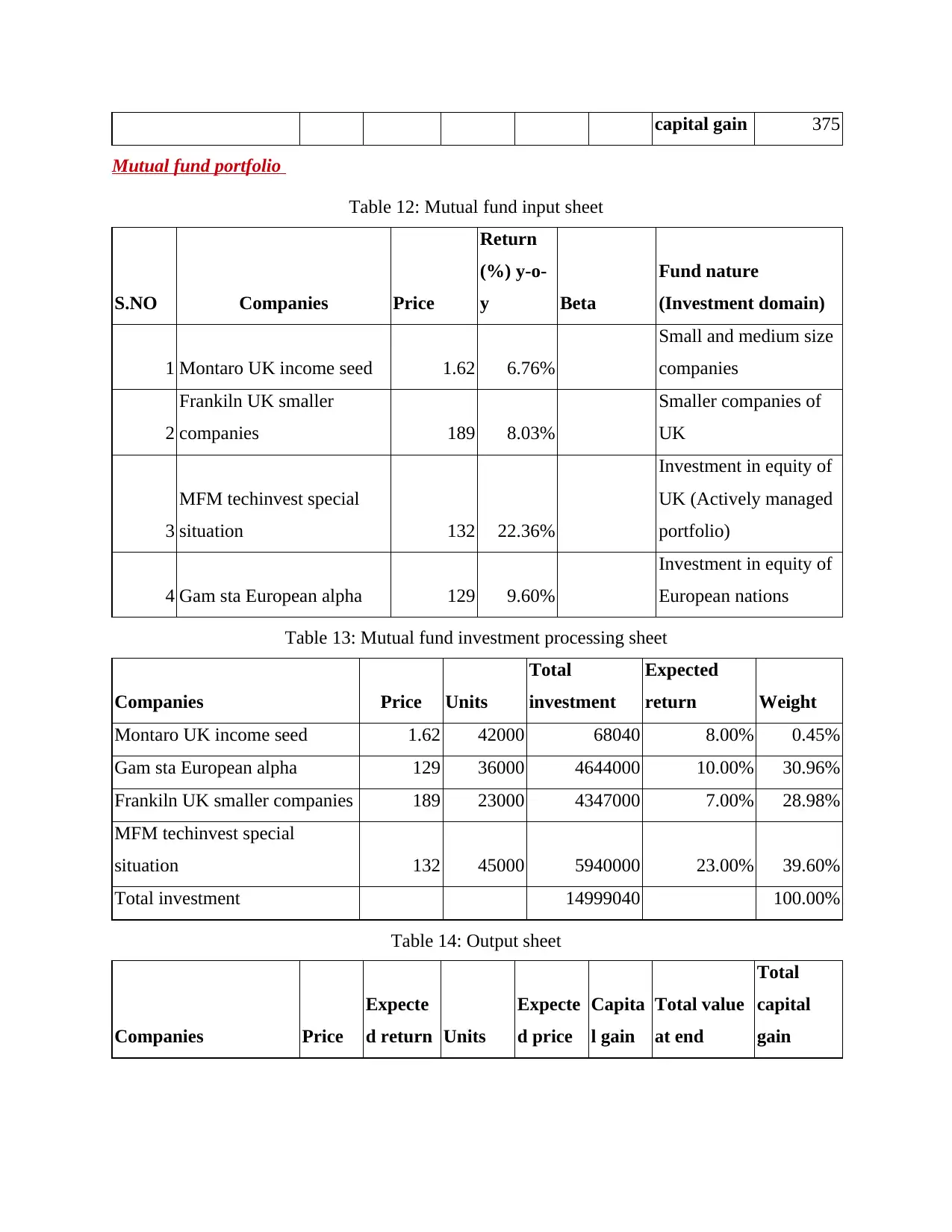
capital gain 375
Mutual fund portfolio
Table 12: Mutual fund input sheet
S.NO Companies Price
Return
(%) y-o-
y Beta
Fund nature
(Investment domain)
1 Montaro UK income seed 1.62 6.76%
Small and medium size
companies
2
Frankiln UK smaller
companies 189 8.03%
Smaller companies of
UK
3
MFM techinvest special
situation 132 22.36%
Investment in equity of
UK (Actively managed
portfolio)
4 Gam sta European alpha 129 9.60%
Investment in equity of
European nations
Table 13: Mutual fund investment processing sheet
Companies Price Units
Total
investment
Expected
return Weight
Montaro UK income seed 1.62 42000 68040 8.00% 0.45%
Gam sta European alpha 129 36000 4644000 10.00% 30.96%
Frankiln UK smaller companies 189 23000 4347000 7.00% 28.98%
MFM techinvest special
situation 132 45000 5940000 23.00% 39.60%
Total investment 14999040 100.00%
Table 14: Output sheet
Companies Price
Expecte
d return Units
Expecte
d price
Capita
l gain
Total value
at end
Total
capital
gain
Mutual fund portfolio
Table 12: Mutual fund input sheet
S.NO Companies Price
Return
(%) y-o-
y Beta
Fund nature
(Investment domain)
1 Montaro UK income seed 1.62 6.76%
Small and medium size
companies
2
Frankiln UK smaller
companies 189 8.03%
Smaller companies of
UK
3
MFM techinvest special
situation 132 22.36%
Investment in equity of
UK (Actively managed
portfolio)
4 Gam sta European alpha 129 9.60%
Investment in equity of
European nations
Table 13: Mutual fund investment processing sheet
Companies Price Units
Total
investment
Expected
return Weight
Montaro UK income seed 1.62 42000 68040 8.00% 0.45%
Gam sta European alpha 129 36000 4644000 10.00% 30.96%
Frankiln UK smaller companies 189 23000 4347000 7.00% 28.98%
MFM techinvest special
situation 132 45000 5940000 23.00% 39.60%
Total investment 14999040 100.00%
Table 14: Output sheet
Companies Price
Expecte
d return Units
Expecte
d price
Capita
l gain
Total value
at end
Total
capital
gain
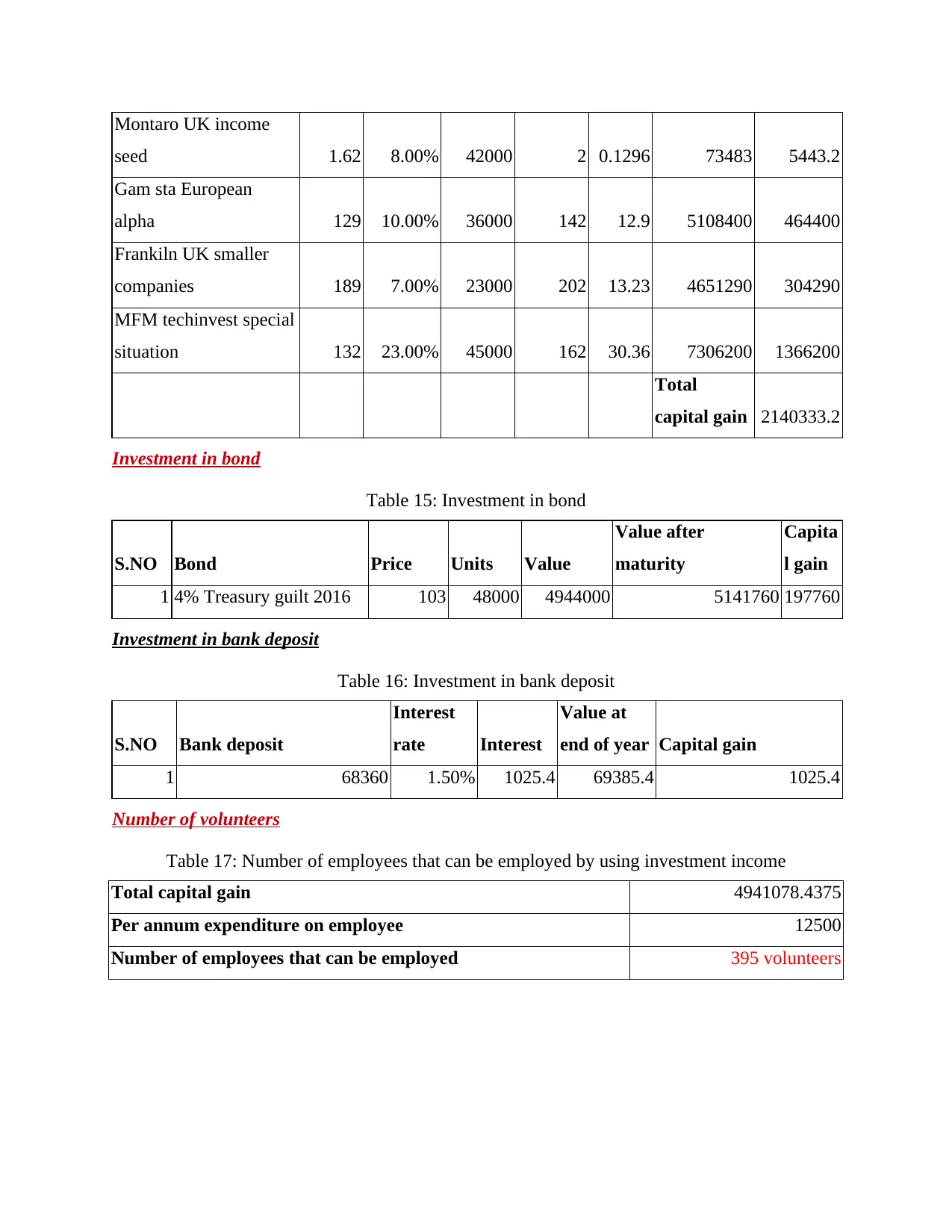
Montaro UK income
seed 1.62 8.00% 42000 2 0.1296 73483 5443.2
Gam sta European
alpha 129 10.00% 36000 142 12.9 5108400 464400
Frankiln UK smaller
companies 189 7.00% 23000 202 13.23 4651290 304290
MFM techinvest special
situation 132 23.00% 45000 162 30.36 7306200 1366200
Total
capital gain 2140333.2
Investment in bond
Table 15: Investment in bond
S.NO Bond Price Units Value
Value after
maturity
Capita
l gain
1 4% Treasury guilt 2016 103 48000 4944000 5141760 197760
Investment in bank deposit
Table 16: Investment in bank deposit
S.NO Bank deposit
Interest
rate Interest
Value at
end of year Capital gain
1 68360 1.50% 1025.4 69385.4 1025.4
Number of volunteers
Table 17: Number of employees that can be employed by using investment income
Total capital gain 4941078.4375
Per annum expenditure on employee 12500
Number of employees that can be employed 395 volunteers
seed 1.62 8.00% 42000 2 0.1296 73483 5443.2
Gam sta European
alpha 129 10.00% 36000 142 12.9 5108400 464400
Frankiln UK smaller
companies 189 7.00% 23000 202 13.23 4651290 304290
MFM techinvest special
situation 132 23.00% 45000 162 30.36 7306200 1366200
Total
capital gain 2140333.2
Investment in bond
Table 15: Investment in bond
S.NO Bond Price Units Value
Value after
maturity
Capita
l gain
1 4% Treasury guilt 2016 103 48000 4944000 5141760 197760
Investment in bank deposit
Table 16: Investment in bank deposit
S.NO Bank deposit
Interest
rate Interest
Value at
end of year Capital gain
1 68360 1.50% 1025.4 69385.4 1025.4
Number of volunteers
Table 17: Number of employees that can be employed by using investment income
Total capital gain 4941078.4375
Per annum expenditure on employee 12500
Number of employees that can be employed 395 volunteers
1 out of 19
Related Documents
Your All-in-One AI-Powered Toolkit for Academic Success.
+13062052269
info@desklib.com
Available 24*7 on WhatsApp / Email
![[object Object]](/_next/static/media/star-bottom.7253800d.svg)
Unlock your academic potential
© 2024 | Zucol Services PVT LTD | All rights reserved.





